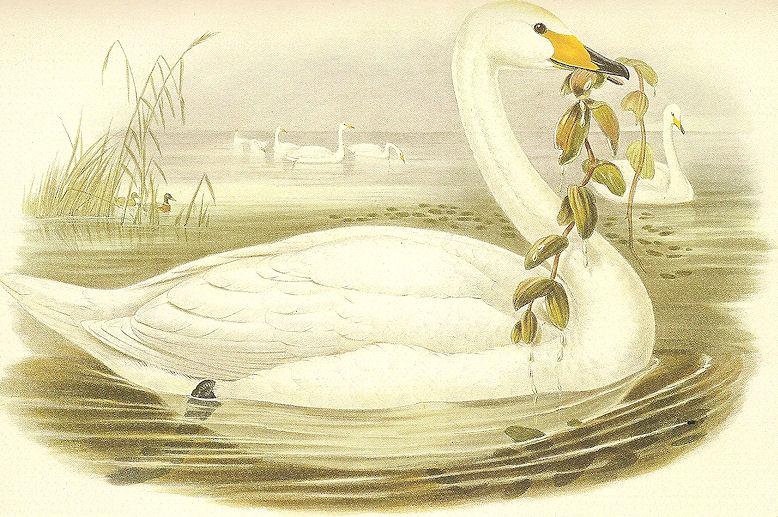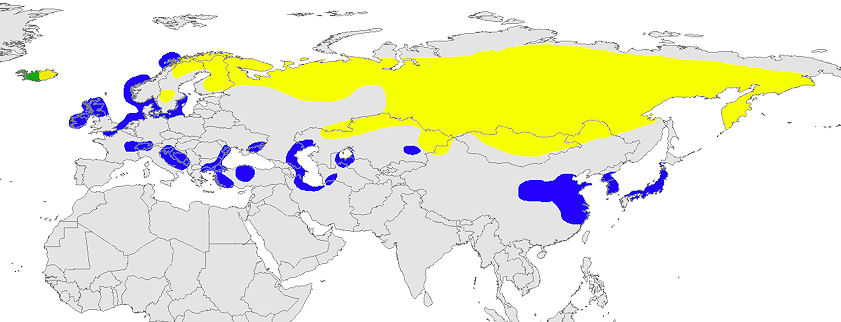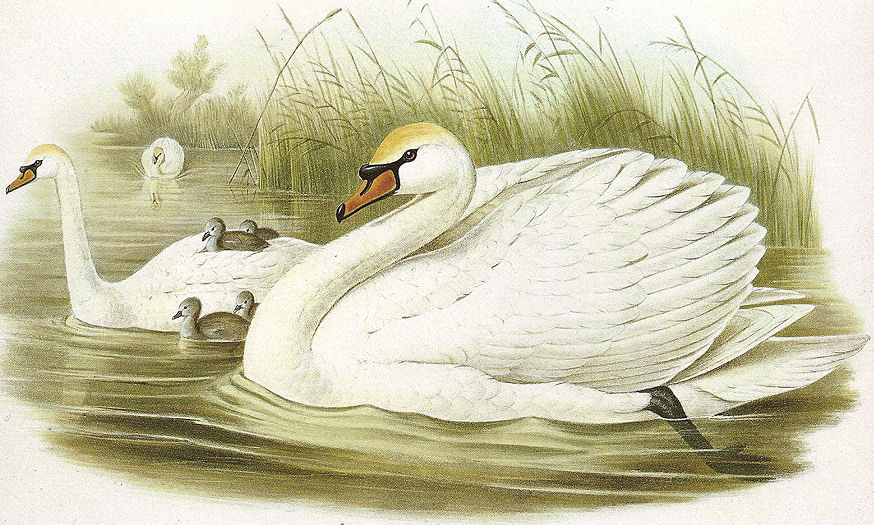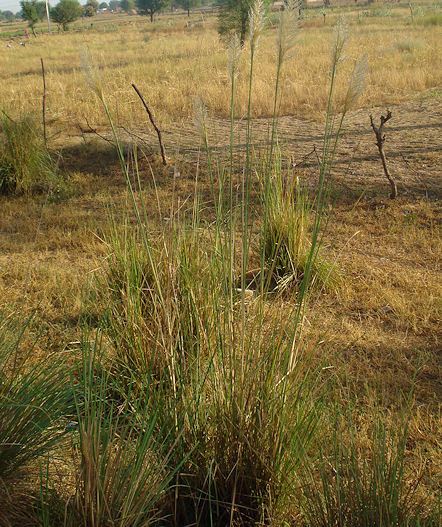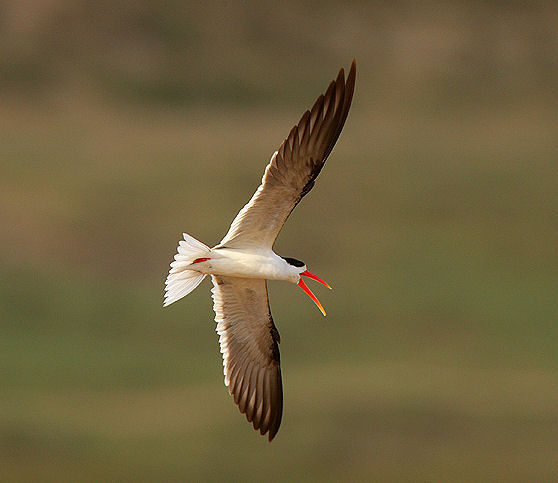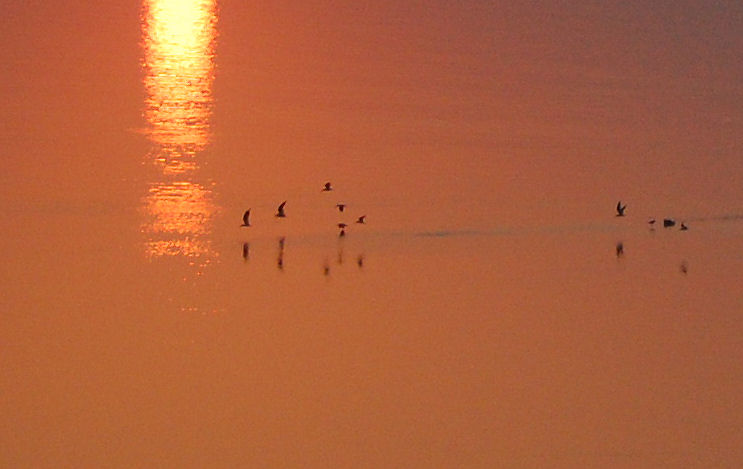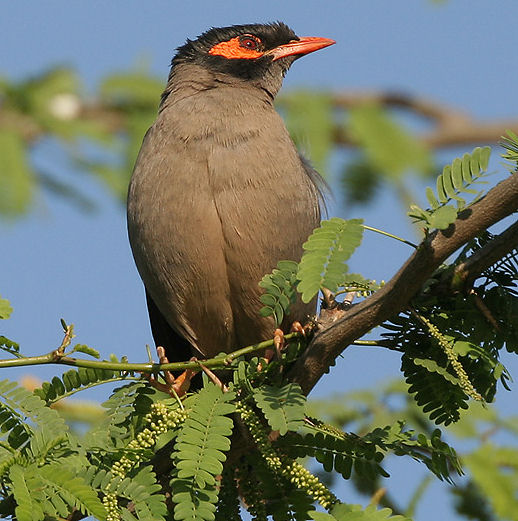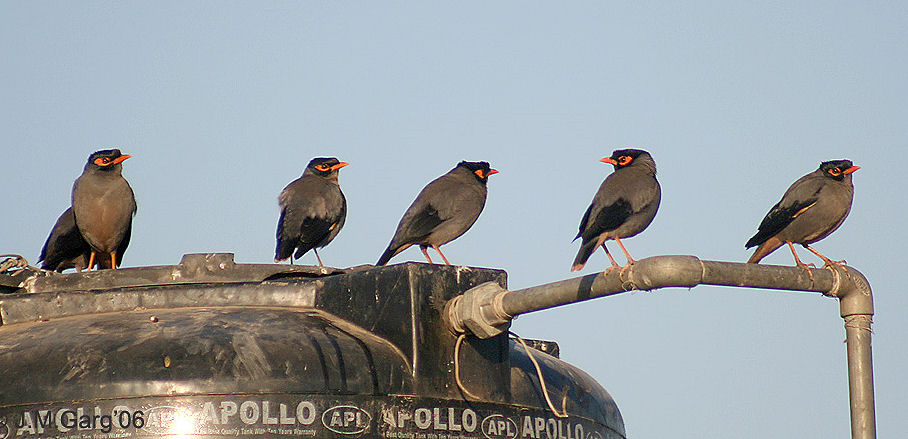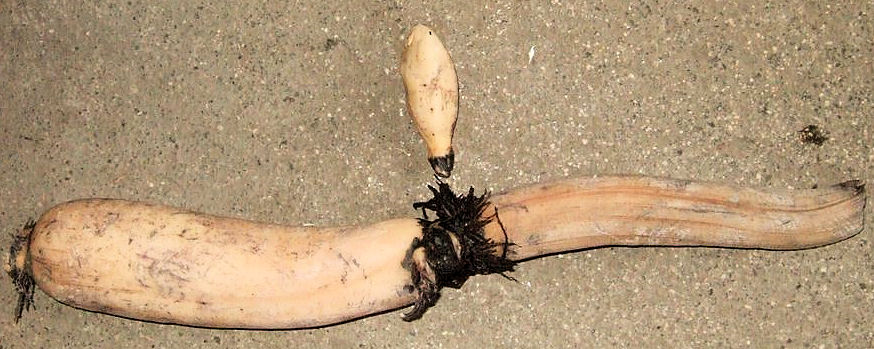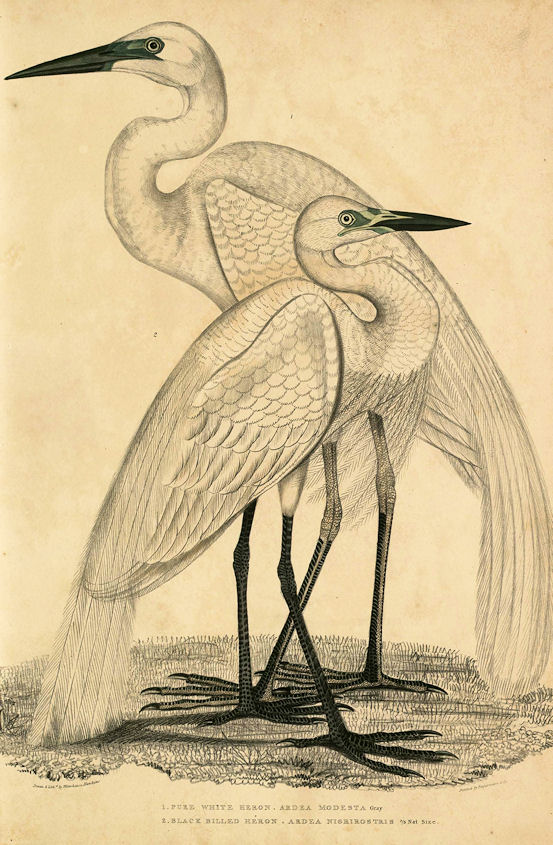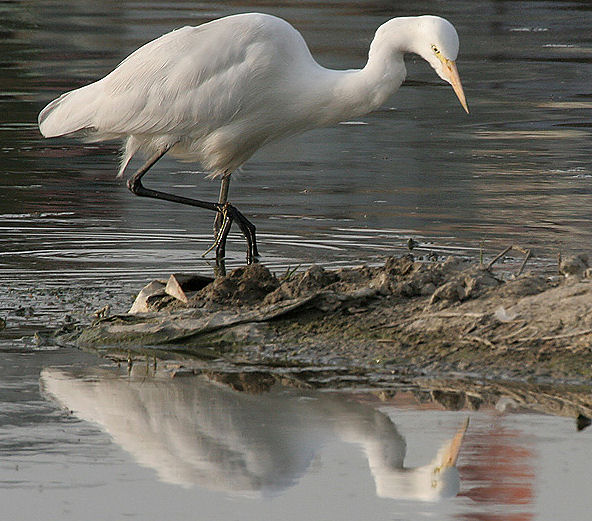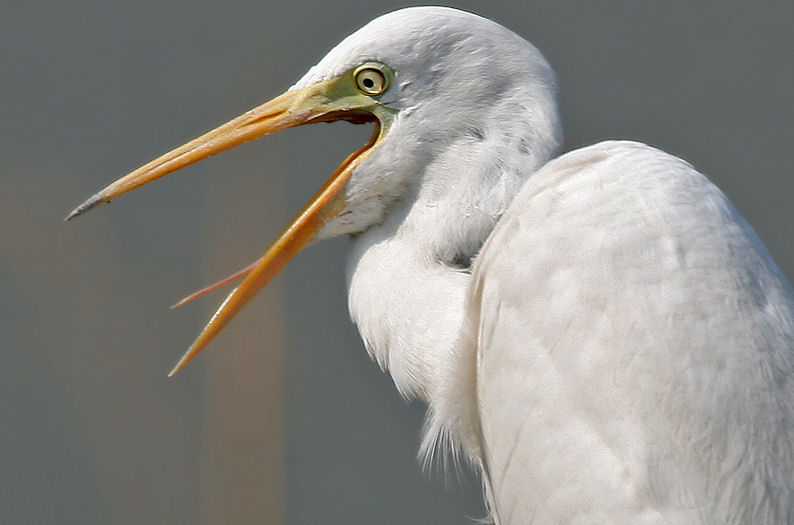|

Meinem Lehrer und Freund
Prof. Dr. Heinrich von
Stietencron
ist die gesamte
Amarakośa-Übersetzung
in Dankbarkeit gewidmet. |
|
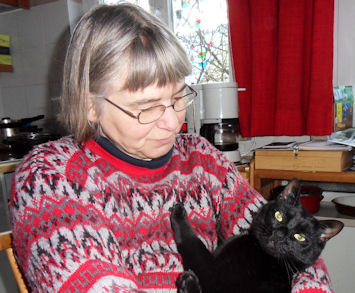
Meiner lieben Frau
Margarete Payer
die all meine Interessen teilt und fördert
ist das Tierkapitel in
Dankbarkeit besonders gewidmet |
Falls Sie die diakritischen Zeichen nicht dargestellt bekommen, installieren Sie
eine Schrift mit Diakritika wie z.B. Tahoma.
Die Devanāgarī-Zeichen sind in Unicode kodiert. Sie benötigen also eine
Unicode-Devanāgarī-Schrift.
|
"Those who have never considered the subject are
little aware how much the appearance and habit of a plant become
altered by the influence of its position. It requires much
observation to speak authoritatively on the distinction in point of
stature between many trees and shrubs. Shrubs in the low country,
small and stunted in growth, become handsome and goodly trees on
higher lands, and to an inexperienced eye they appear to be
different plants. The Jatropha curcas grows to a tree some 15
or 20 feet on the Neilgherries, while the Datura alba is
three or four times the size in>n the hills that it is on the
plains. It is therefore with much diffidence that I have
occasionally presumed to insert the height of a tree or shrub. The
same remark may be applied to flowers and the flowering seasons,
especially the latter. I have seen the Lagerstroemia Reginae,
whose proper time of flowering is March and April, previous to the
commencement of the rains, in blossom more or less all the year in
gardens in Travancore. I have endeavoured to give the real or
natural flowering seasons, in contradistinction to the chance ones,
but, I am afraid, with little success; and it should be recollected
that to aim at precision in such a part of the description of plants
is almost hopeless, without that prolonged study of their local
habits for which a lifetime would scarcely suffice."
[Quelle: Drury, Heber <1819 - 1872>:
The useful plants of India : with notices of their chief value in
commerce, medicine, and the arts. -- 2d ed. with additions and
corrections. London : Allen, 1873. -- xvi, 512 p. ; 22 cm. -- S.
VIII f.] |
2. dvitīyaṃ kāṇḍam - Zweiter Teil
2.9. siṃhādivargaḥ - Abschnitt über Löwen und andere
Tiere
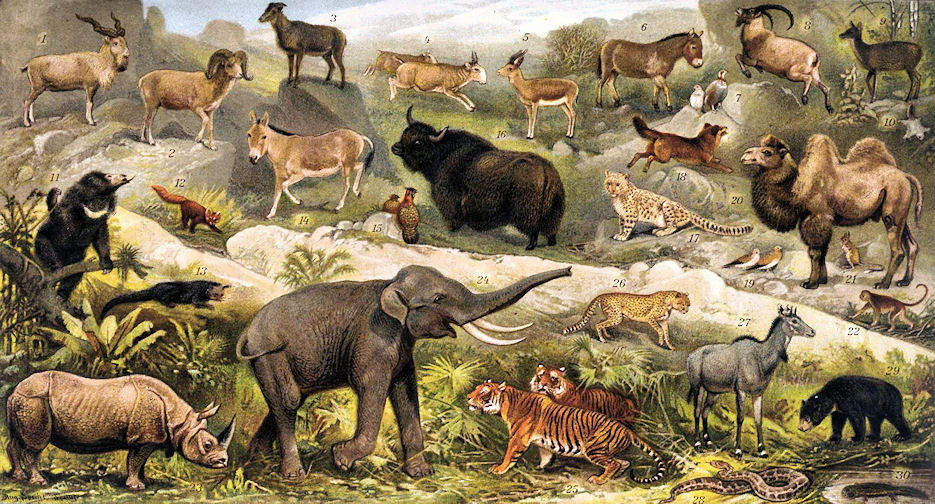
Abb.: Asiatische Tierwelt
[Bildquelle: Brockhaus' Kleines Konversationslexikon, 1906]
Referenzwerke:
Dave, K. N.
<1884 - 1983>: Birds in Sanskrit literature. -- Delhi : Motilal
Banarsidass, 1985. -- XXIV, 481 S. : Ill. -- ISBN 0-89581-676-8. [Referenz
für Sanskritbezeichnungen von Vögeln]
Handbook of the
birds of India and Pakistan : together with
those of Bangladesh, Nepal, Bhutan and Sri Lanka ; [in 10 vol.] / Sálim Ali
and S. Dillon Ripley. -- Delhi : Oxford Univ. Pr., 1968 - 1974 [Referenzwerk
für Vögel Indiens]
Kazmierczak, Krys
[Text] ; Berlo, Per van [Ill.]: A field guide to the birds of the
Indian subcontinent. -- New Haven : Yale University Press, ©2000. -- 352 S.
: Ill. -- . ISBN 0300079214. [Neue, durchgehend farbig illustrierte
Übersicht über 1330 Vogelarten Indiens]
Rasmussen, Pamela C. ; Anderton, John C.: Birds of
South Asia : the Ripley Guide. -- Washington, D. C. : Smithsonian, 2005. --
2 Bde. -- ISBN 84-87334-67-9. [DAS Standardwerk]
Übersicht
- 2.9.57. Tadorna ferruginea Pallas, 1764 - Ruddy Shelduck -
Rostgans
- 2.9.58. Anser sp. - Feldgänse - Geese
- 2.9.59. Seevögel: Laridae - Möwen - Gulls & Sternidae - Seeschwalben - Terns &
Pandionidae - Fischadler - Ospreys & Haliaeetus sp. - Seeadler - See Eagles
- 2.9.60. Anatidae - Entenvögel (Schwäne, Gänse, Enten) - Swans, Geese, Ducks
- 2.9.61. Cygnus sp. - Swans - Schwäne
- 2.9.62. Rynchops albicollis Swainson, 1838 - Indian Skimmer -
Halsband-Scherenschnabel {& Pseudibis papillosa Temminck, 1824 - Black
Ibis - Warzenibis}
- 2.9.63. Egretta intermedia Wagler, 1827 - Intermediate Egret -
Mittelreiher
- 2.9.64. Weibchen
2.9.57. Tadorna ferruginea Pallas, 1764 - Ruddy Shelduck -
Rostgans
66 cm
|
22. c./d. kokaś cakraś cakravāko rathāṅgāhvaya-nāmakaḥ
कोकश् चक्रश् चक्रवाको रथाङ्गाह्वय-नामकः ॥२२ ख॥
[Bezeichnungen für
Tadorna ferruginea Pallas, 1764 - Ruddy Shelduck -
Rostgans:]
-
कोक - koka m.: Koka
- चक्र -
cakra m.: "Rad" = "Tadorna ferruginea, Ruddy Sheldrake (Common Shalduck)." (Dave,
494)
- चक्रवाक
-
cakravāka m.: "Rad-Geschnatter" = "Tadorna ferruginea, Ruddy Sheldrake (Common Sheduck)."
(Dave, 494)
- रथाङ्गाह्वय - rathāṅgāhvaya: alle
Bezeichnungen für "Wagenrad"
|
Colebrooke (1807): "The ruddy goose."
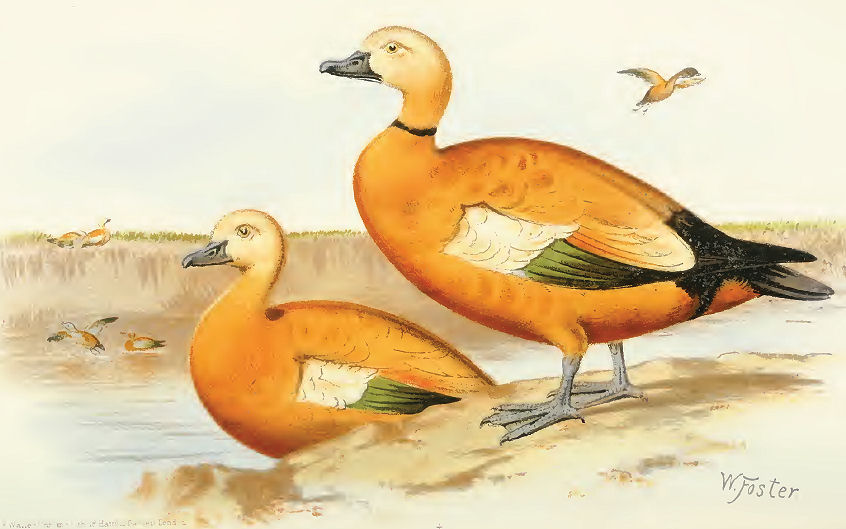
Abb.: चक्रवाकौ । Tadorna ferruginea Pallas, 1764 - Ruddy Shelduck -
Rostgans
[Bildquelle: Indian sporting birds. -- 1915.]
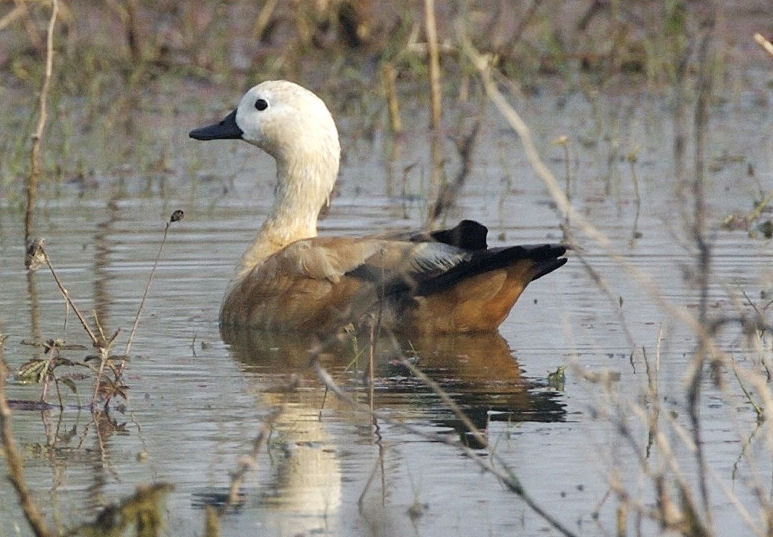
Abb.: चक्रवाकः । Tadorna ferruginea Pallas, 1764 - Ruddy Shelduck - Rostgans,
Weibchen, Keoladeo
National Park - केवलादेव राष्ट्रीय उद्यान, Rajasthan
[Bildquelle: Lip Kee. --
http://www.flickr.com/photos/lipkee/3272282698/. -- Zugriff am 2010-12-21.
-- Creative
Commons Lizenz (Namensnennung, share alike)]
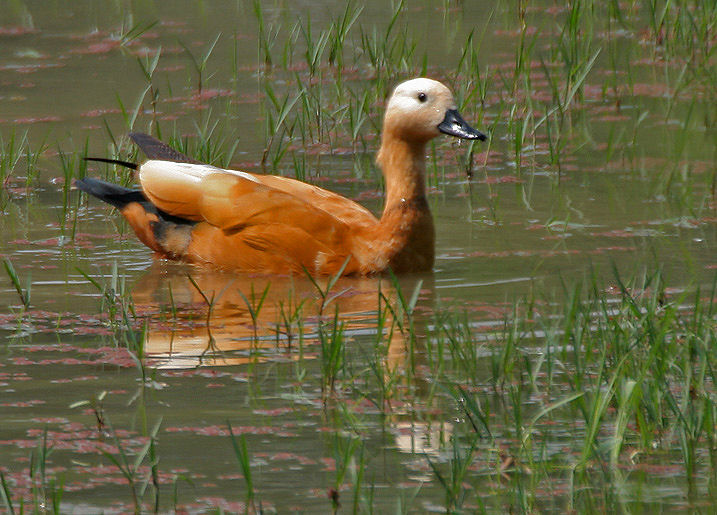
Abb.: चक्रवाकः । Tadorna ferruginea Pallas, 1764 - Ruddy Shelduck - Rostgans,
Weibchen, Keoladeo
National Park - केवलादेव राष्ट्रीय उद्यान, Rajasthan
[Bildquelle: J. M. Garg / Wikimedia. -- GNU FDLicense]
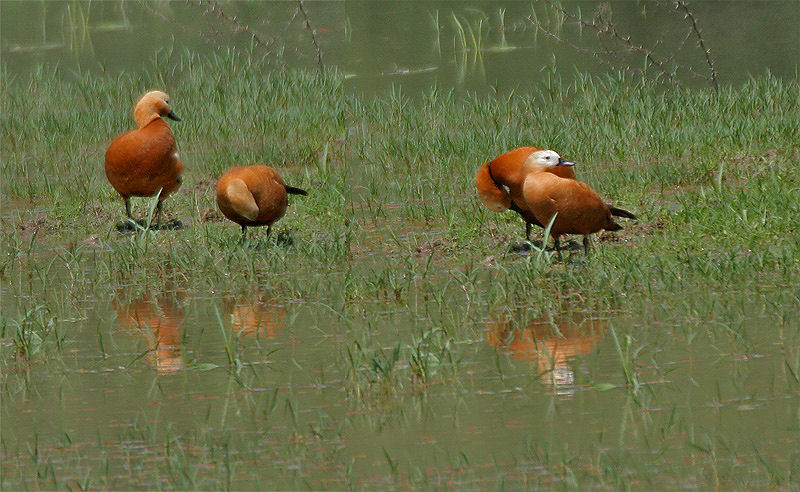
Abb.: चक्रवाकाः । Tadorna ferruginea Pallas, 1764 - Ruddy Shelduck - Rostgans, Keoladeo
National Park - केवलादेव राष्ट्रीय उद्यान, Rajasthan
[Bildquelle: J. M. Garg / Wikimedia. -- GNU FDLicense]
|
"Habitat. Sind, Persia, Beloochistan, Afghanistan,
E. Turkistan, Punjab, N.-W, Provinces, Oudh, Nepaul, Bengal, Rajputana,
Central India, Kutch, Guzerat, the Concans, Deccan and Southern
India.
The Ruddy Shelldrake is a winter visitant to
India. In Sind it is found on all the large lakes and brooks and along the
Indus river in great numbers ; and on the Munchur especially ; like geese, large
parties resort to the fields of sprouting wheat in the early morning and at
night-fall, and do much damage. They are extremely shy and wary birds, and as
Mr. Reid, in Game Birds, remarks "It will not only keep a sharp look-out on its
own account, but will fly along the Jheel side before the gunner,
uttering its warning note and put every bird on the qui vive""
[Quelle: Murray, James A.:
The avifauna of British India and its dependencies. -- London : Trübner,
1888-1890. -- 2 Bde. -- Bd. 2, S. 680.] |
|
"The Ruddy Shieldrake or Braminy Duck, as it
is called in India, is a well known winter visitant to all
parts of the country. It is generally seen, even at this season, in
pairs or small parties, frequenting alike rivers, brooks, jheels,
and lakes. It walks well on the ground and grazes in the young cornfields
just like Geese ; it also picks up seeds of grass, grain, &c. A
writer in the Indian Sporting Review for 1854 states, that "it
Is often found devouring carrion on the banks of rivers, and is
frequently seen banqueting in company with Vultures, and associating with
such other villainous companions." This must be a very rare
occurrence; I have constantly, when on the Ganges and other large rivers,
been on the watch to verify this observation, but as yet have
never seen anything approaching to such a habit, and I have
moreover questioned many sportsmen on the subject with a like
result. Towards the close of the cold weather, the Braminy Ducks
assemble in numbers, and on the Chilka lake I have seen thousands
in one flock in April. The call is peculiar and Goose-like, (like a
clarionet, says Pallas) sounding something like ā-oung, and hence the
name of Aangir, which, according to Pallas, is given to this
bird among the Mongols, by whom it is held sacred.
It is found over the greater part of Central
Europe, being occasionally even killed in Britain ; also in Northern
Africa, and great part of Asia, not extending however far
north. It breeds across the Himalayas on rocks near lakes, as
observed by Hooker and Adams respectively in Sikim and Ladakh ; also
in holes of walls, and occasionally in deserted holes in the
ground. Salvin found it breeding on almost inaccessible cliffs in
Northern Africa far from water, along with Kites and Ravens, and he
states that he procured four white eggs ; other observers say that it
lays from eight to ten. It has bred in the Zoological gardens, and
reared four young ones.
The Hindoos have a legend that two lovers
for some indiscretion were transformed into Braminy Ducks, that
they are condemned to pass the night apart from each other on
opposite banks of the river, and that all night long each, in its turn,
asks its mate if it shall come across, but the question is always met by a
negative—''Chakwa, shall I come ? No, Chakwi." "Chakwi, shall I
come ? No Chakwa."
Pallas states that it does not
extend beyond 50° N. L., and that it usually nestles in Marmot's holes,
also in rocks, and occasionally even in hollow trees. It is held
sacred by the Mongols and Calmucs."
[Quelle: Jerdon,
T. C. (Thomas Claverhill) <1811-1872>: The birds of India. --
Calcutta, 1862. -- Vol 2,2. -- S. 792f.] |
2.9.58. Anser sp. - Feldgänse - Geese
|
23. a./b. kādambaḥ kalahaṃsaḥ syād
utkrośa-kurarau samau कादम्बः कलहंसः स्याद्
उत्क्रोश-कुररौ समौ ।२३ क।
[Bezeichnungen für
Anser sp. - Feldgänse - Geese:]
- कादम्ब
- kādamba m.: "Kādamba-Gras, Pfeil" = "Anser indicus, Bar-headed Goose." (Dave, 488)
- कलहंस - kalahaṃsa m.:
"zart-tönende Gans" = "stays for all grey Geese; esp. Anser anser, Greylag
Goose; also Anser fabalis, Bean Goose; Anser albifrons, (Greater)
White-fronted Goose."
|
Colebrooke (1807): "A drake."
Anser indicus Latham, 1790 - Bar-headed Goose - Streifengans
75 cm
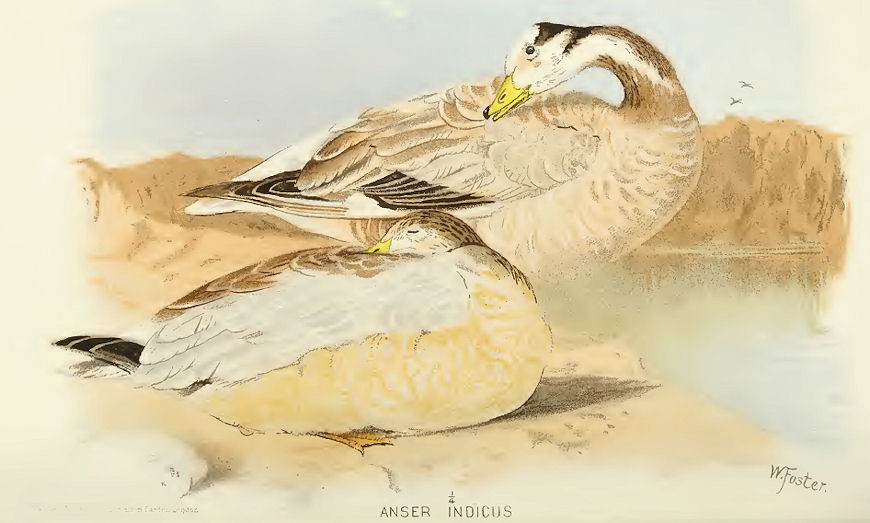
Abb.: कादम्बौ । Anser indicus Latham, 1790 - Bar-headed Goose - Streifengans
[Bildquelle: Indian sporting birds. -- 1915.]
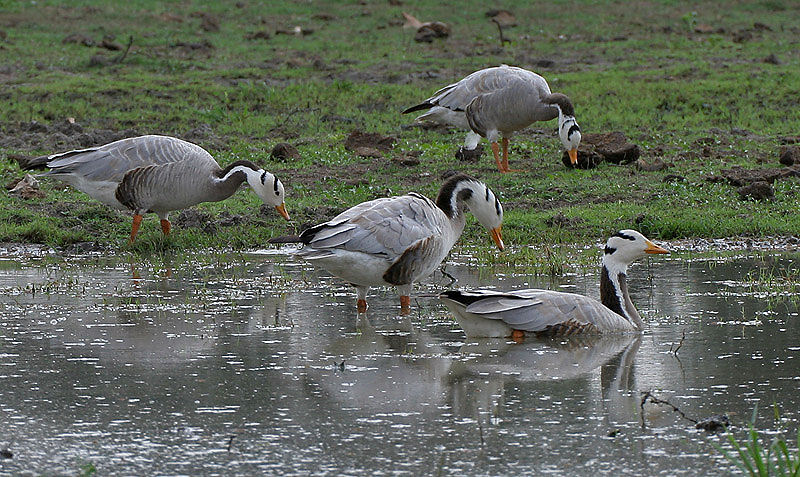
Abb.: कादम्बाः । Anser indicus Latham, 1790 - Bar-headed Goose - Streifengans, Keoladeo
National Park - केवलादेव राष्ट्रीय उद्यान, Rajasthan
[Bildquelle: J. M. Garg / Wikimedia. -- GNU FDLicense]
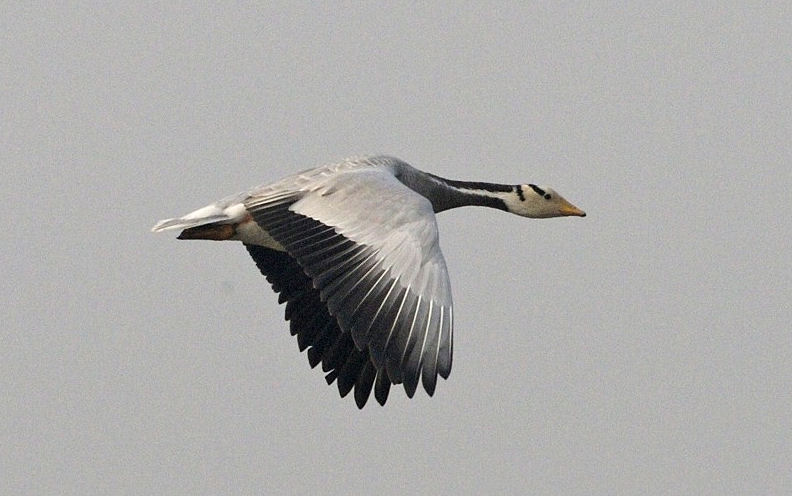
Abb.: कादम्बः । Anser indicus Latham, 1790 - Bar-headed Goose - Streifengans, Keoladeo
National Park - केवलादेव राष्ट्रीय उद्यान, Rajasthan
[Bildquelle: Lip Kee. --
http://www.flickr.com/photos/lipkee/3272103362/. -- Zugriff am 2010-12-21.
-- Creative
Commons Lizenz (Namensnennung, share alike)]
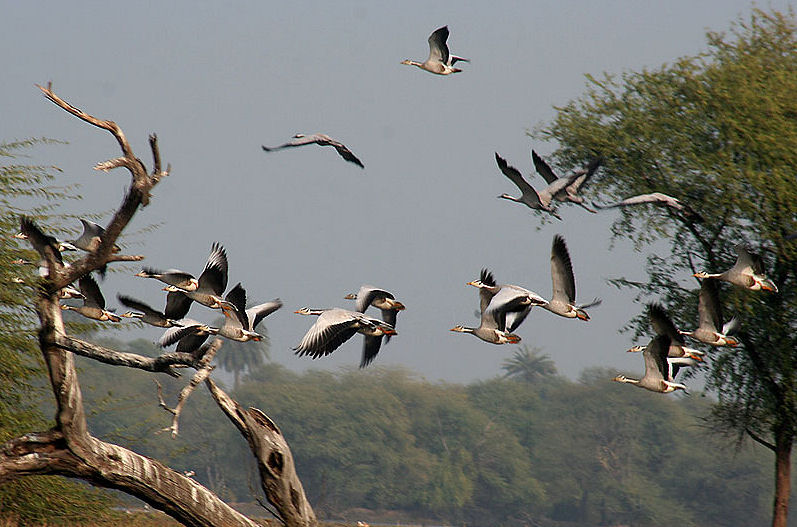
Abb.: कादम्बाः । Anser indicus Latham, 1790 - Bar-headed Goose - Streifengans, Keoladeo
National Park - केवलादेव राष्ट्रीय उद्यान, Rajasthan
[Bildquelle: J. M. Garg / Wikimedia. -- GNU FDLicense]
|
"Habitat. Sind, Punjab, N.-W. Provinces, Oudh,
Central Provinces, and Bengal. A winter visitant.
This is certainly the most abundant Goose in
Sind, and during the winter may be met in flocks of thousands on the
large lakes, and on the Indus. On the Munchur it simply swarms, and not unlike
the two other species, albifrons and cinereus, feeds during the night and in
the early morning till about 9 or 10 o'clock. They feed exclusively on tender
shoots of grass, and do much damage to the sprouting corn crops,
especially in the neighbourhood of the Munchur, also in Lower Sind. Taking Upper
India (including Sind), Hume says "This species enormously outnumbers all
the other species of Geese put together." I think at least five of the
Barred-heads visit India to every one of the Grey Lags, and as for all the rest of
the Geeser they are apparently so rare, that when one comes to consider
numbers, they are not worth speaking about. * * * Their habits are similar to
those of the Grey Lags. Where frequently disturbed they feed inland only at
night ; where rarely molested they will be found feeding up to eight or nine in
the morning and again long before sunset. Preferentially they feed in fields in
the neighbourhood of the larger rivers, browsing on the young wheat, vetches,
lentils, &c. They are not difficult to bag, especially in localities where they
are not disturbed by shooting. Walking besides a pony, or bullock, one can
always get within 35 or 40 yards of a flock, and bag at least a dozen birds
with a couple of effective shots. In localities which have been frequently shot
over the birds are very wary, and unless there is plenty of cover a buffalo or
pony becomes a necessity."In such cases," as Mr. Hume says, "it is best to make sure of your one en
two birds on the ground with the first shot, as you
will seldom have time for more than one shot after they rise." Mr. Hume, in
his Game Birds of India, gives many hints as to shooting geese and wild fowl
generally. The habits of the Duck tribe and the various methods adopted
for netting them are very interesting, and of much value to sportsmen generally."
[Quelle: Murray, James A.:
The avifauna of British India and its dependencies. -- London : Trübner,
1888-1890. -- 2 Bde. -- Bd. 2, S. 676.] |
|
"This Goose appears to be peculiar to India,
and probably the adjacent countries north of the Himalayas,
where it breeds, as it is not recorded by Pallas as a bird of
Northern or Central Asia. It is chiefly a winter visitant to
India, arriving in Northern India towards the end of October or beginning
of November, and leaving in March. It is occasionally met with
in immense flocks of many hundreds, usually in smaller parties.
It grazes on the river banks and fields of corn, chenna, &c.,
retiring about 10 or 11 a. M. to some tank or river, where it
reposes during the greater part of the day, returning to the fields in
the afternoon. A writer in the Bengal Sporting Magazine states that
this Goose is found in immense abundance both in Bundlekund and in
the country between Agra and Gwalior ; but that the larger kind
(A. cinereus) is not met with in the latter locality. I once
saw a couple of these Geese in the extreme south of India in
August, in a small sequestered tank. This pair may have been breeding there,
but perhaps they were wounded or sickly birds.
This Goose probably breeds in the large lakes beyond the
Himalayas, where swarms of water-birds have been observed by various
travellers in summer. It is excellent eating, but perhaps in this
respect inferior to the Grey Goose."
[Quelle: Jerdon,
T. C. (Thomas Claverhill) <1811-1872>: The birds of India. --
Calcutta, 1862. -- Vol 2,2. -- S. 782f.] |
Anser anser Linnaeus, 1758 - Greylag Goose - Graugans
81 cm
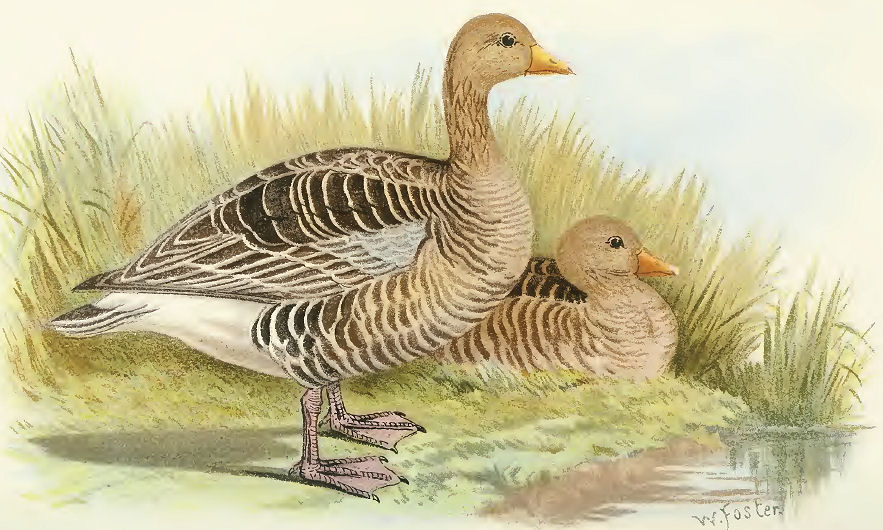
Abb.: कलहंसौ । Anser anser Linnaeus, 1758 - Greylag Goose - Graugans
[Bildquelle: Indian sporting birds. -- 1915.]
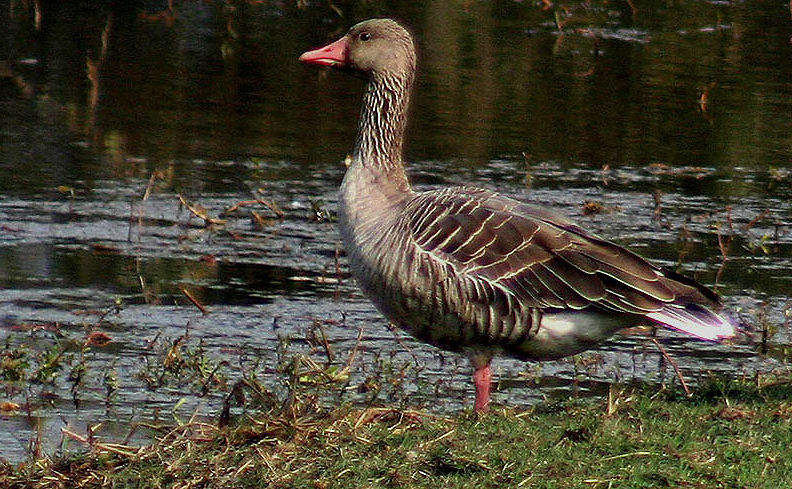
Abb.: कलहंसः । Anser anser Linnaeus, 1758 - Greylag Goose - Graugans, Keoladeo
National Park - केवलादेव राष्ट्रीय उद्यान, Rajasthan
[Bildquelle: J. M. Garg / Wikimedia. -- GNU FDLicense]
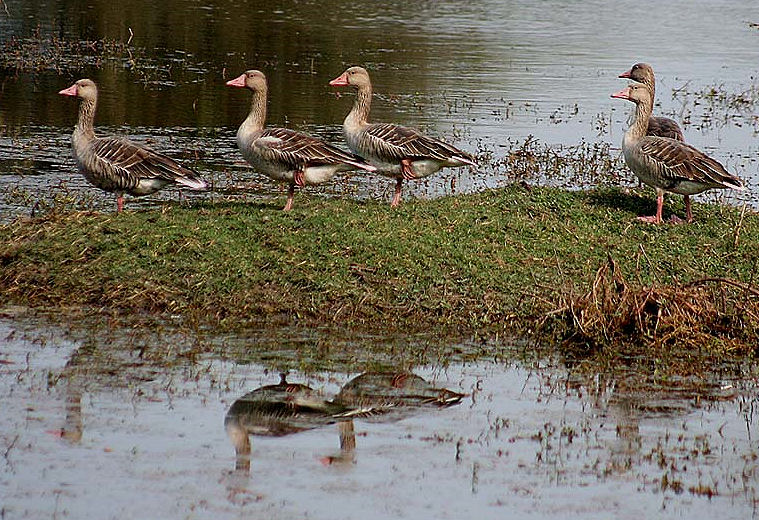
Abb.: कलहंसाः । Anser anser Linnaeus, 1758 - Greylag Goose - Graugans, Keoladeo
National Park - केवलादेव राष्ट्रीय उद्यान, Rajasthan
[Bildquelle: J. M. Garg / Wikimedia. -- GNU FDLicense]

Abb.: कलहंसः । Anser anser Linnaeus, 1758 - Greylag Goose - Graugans, Keoladeo
National Park - केवलादेव राष्ट्रीय उद्यान, Rajasthan
[Bildquelle: Lip Kee. --
http://www.flickr.com/photos/lipkee/3271282773/. -- Zugriff am 2010-12-21.
-- Creative
Commons Lizenz (Namensnennung, share alike)]
|
"Habitat. Sind, Afghanistan, Punjab, N.-W.
Provinces, Oudh, Bengal, Rajputna, Kutch and Guzerat. Occurs throughout Europe.
About the Munchur Lake in Sind they are met with in large
parties, also along the canals, and especially the river."
[Quelle: Murray, James A.:
The avifauna of British India and its dependencies. -- London : Trübner,
1888-1890. -- 2 Bde. -- Bd. 2, S. 673.] |
|
"The common wild Goose, or grey lag Goose of
England, is a common winter visitant to the North of India,
extending its migrations to Central India, but rarely seen
further South. It is sometimes met with in small parties of from
four to twenty ; occasionally in vast flocks, which feed on young corn,
grass, &c., and, during the heat of the day, rest on some
sand-bank in the large rivers, or in the middle of a tank. This
Goose is a wary bird, approached with difficulty when feeding, but
may occasionally be stalked when on the bank of a river or tank ;
I have often killed it from a boat. The flesh is excellent. In the
wild state it breeds in Northern Europe and Asia, making a large
nest among the rushes, and laying from eight to twelve
whitish eggs. It is the origin of the domestic Goose. It is very
similar to, and is occasionally confounded with the Bean-goose of England, A. segetum, but that species is smaller, with the bill
proportionally smaller and differing in colour."
[Quelle: Jerdon,
T. C. (Thomas Claverhill) <1811-1872>: The birds of India. --
Calcutta, 1862. -- Vol 2,2. -- S. 779f.] |
Anser fabalis Latham, 1787 - Bean Goose - Saatgans
76 cm
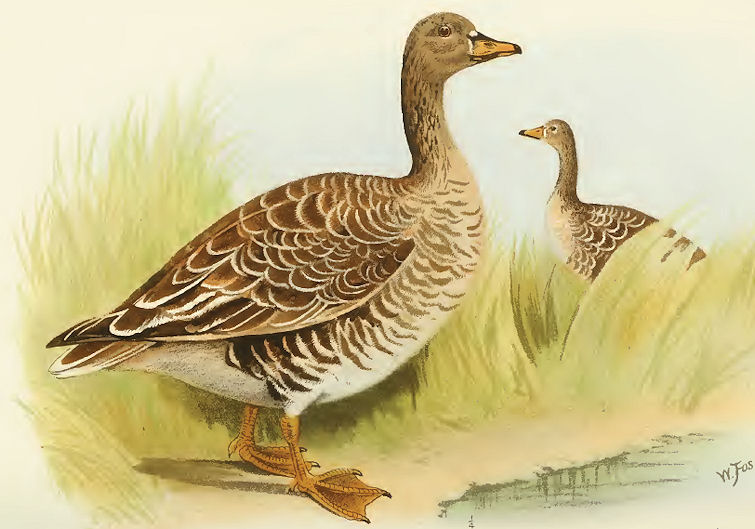
Abb.: कलहंसौ । Anser fabalis Latham, 1787 - Bean Goose - Saatgans
[Bildquelle: Indian sporting birds. -- 1915.]
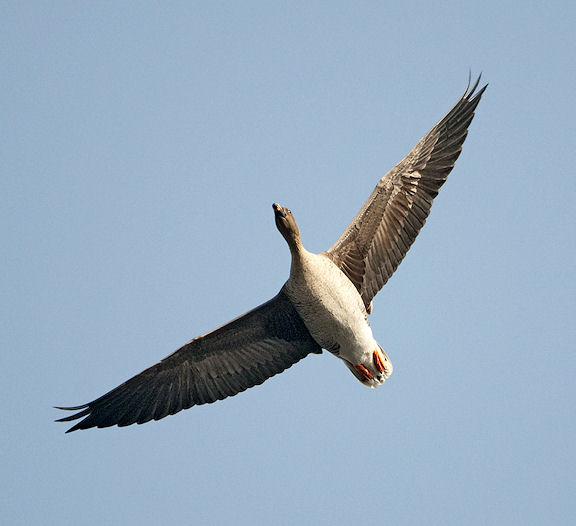
Abb.: कलहंसः । Anser fabalis Latham, 1787 - Bean Goose - Saatgans, Moscow region,
Vinogradovo flood-lands, Russland
[Bildquelle: Sergey Yeliseev. --
http://www.flickr.com/photos/yeliseev/4506446650/in/photostream/. -- Zugriff
am 2010-12-21. --
Creative
Commons Lizenz (Namensnennung, keine kommerzielle Nutzung, keine
Bearbeitung)]
Anser albifrons Scopoli, 1769 - White-fronted Goose - Blässgans
68 cm
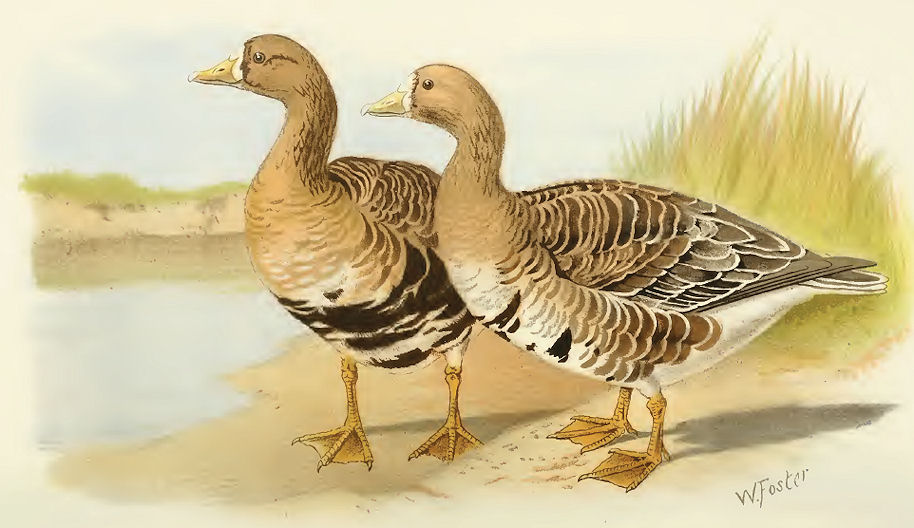
Abb.: कलहंसौ । Anser albifrons Scopoli, 1769 - White-fronted Goose - Blässgans
[Bildquelle: Indian sporting birds. -- 1915.]
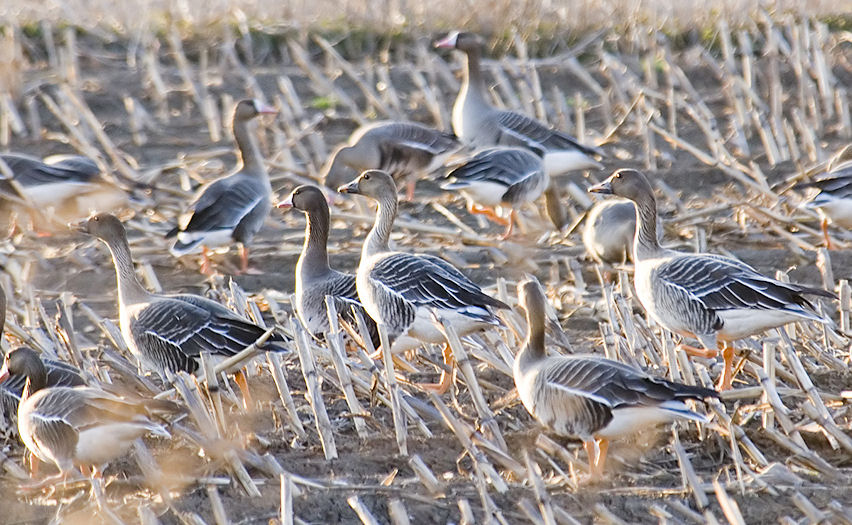
Abb.: कलहंसाः । Anser albifrons Scopoli, 1769 - White-fronted Goose - Blässgans,
Moscow region, Lovtsy, Russland
[Bildquelle: Sergey Yeliseev. --
http://www.flickr.com/photos/yeliseev/2401769940/. -- Zugriff am 2010-12-21.
-- Creative
Commons Lizenz (Namensnennung, keine kommerzielle Nutzung, keine
Bearbeitung)]
|
"Habitat. Sind, Beloochistan (Quetta), Persian
Gulf (Bussorah), Afghanistan (Arghandab), Punjab, N.-W. Provinces and Oudh. In Sind the White-fronted Goose is much more
rare than the Grey Lag. Mr. Hume says "that about one bird of this
species visits this empire, for every thousand of Grey Lags, or every five thousand
of the Barred-headed Geese." In Egypt it is most abundant, also at Fao in Mesopotamia,
and on the Caspian."
[Quelle: Murray, James A.:
The avifauna of British India and its dependencies. -- London : Trübner,
1888-1890. -- 2 Bde. -- Bd. 2, S. 675.] |
|
"The white-fronted Goose has, within our
territories, only been observed hitherto in the Punjab, Adams
stating that it is a winter visitant to the lakes and rivers of that
province. It is found throughout Europe, Northern Asia, and North
America. It is stated to frequent marshes and rarely to visit corn-fields."
[Quelle: Jerdon,
T. C. (Thomas Claverhill) <1811-1872>: The birds of India. --
Calcutta, 1862. -- Vol 2,2. -- S. 781.] |
2.9.59. Seevögel:
Laridae - Möwen - Gulls
& Sternidae - Seeschwalben - Terns
& Pandionidae - Fischadler - Ospreys
& Haliaeetus sp. - Seeadler - See Eagles
|
23. a./b.
kādambaḥ kalahaṃsaḥ syād
utkrośa-kurarau samau कादम्बः कलहंसः
स्याद् उत्क्रोश-कुररौ समौ ।२३ क।
[Bezeichnungen für
Seevögel: Laridae - Möwen - Gulls & Sternidae - Seeschwalben - Terns & Pandionidae - Fischadler - Ospreys & Haliaeetus sp. - Seeadler - See Eagles:]
- उत्क्रोश
-
utkrośa m.: "Schreier" = "any of the Laridae, Larini and Sternini tribes
(Gull, Tern); also Fishing (Fish) and Sea Eagles." (Dave, 485)
- कुरर -
kurara m.: Kurara = "Pandion haliaetus, Osprey; also Fisching (Fish) Eagles or Sea
Eagles; any Laridae of the Larini tribe (Gull), and sometimes the
Sternini tribe (Tern); Numenius arquata, (Eurasian) Curlew;
Grus virgo, Demoiselle Crane; according to Dave, Terns, or Numenius
arquata, (Eurasian) Curlew; are the birds whose calls may be compared to the
sorrowful wail of women." (Dave, 489)
|
Colebrooke (1807): "An osprey."
Im Folgenden einige Beispiele.
Numenius arquata Linnaeus, 1758 - Eurasian Curlew - Großer Brachvogel
58 cm
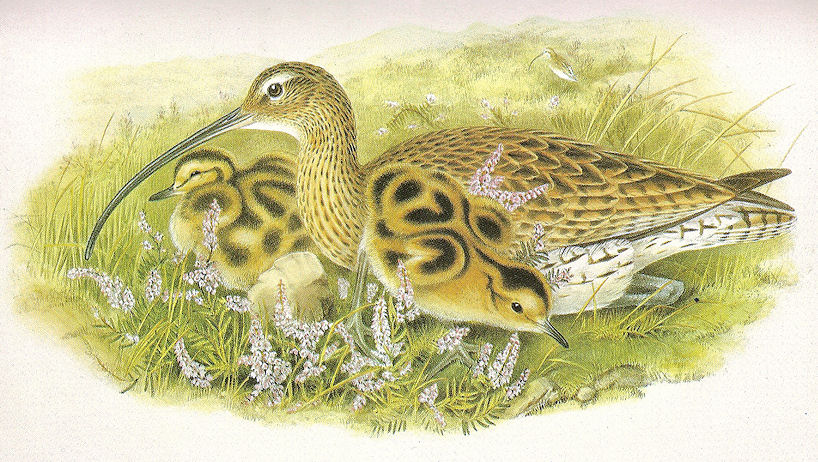
Abb.: कुरराः । Numenius arquata Linnaeus, 1758 - Eurasian Curlew - Großer Brachvogel
[Bildquelle: Gould, Birds of Great Britain, 1862 - 1873]
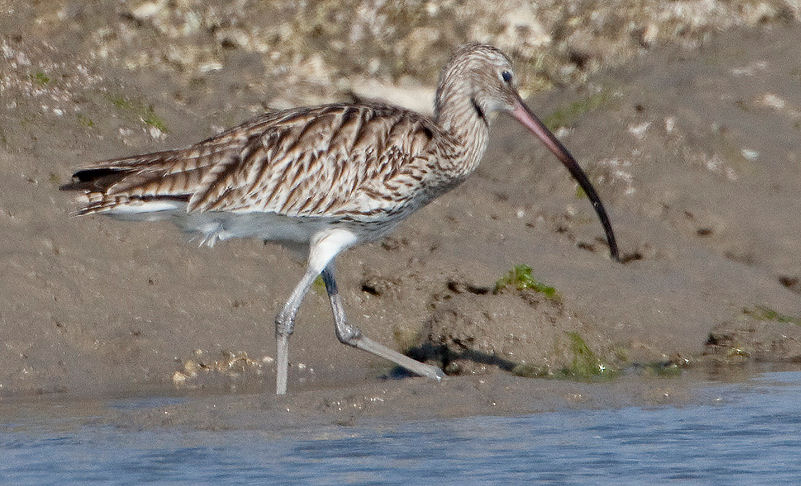
Abb.: कुररः । Numenius arquata Linnaeus, 1758 - Eurasian Curlew - Großer
Brachvogel, Rann of Kutch - કચ્છનું મોટું રણ,
Gujarat
[Bildquelle:
Tarique Sani. --
http://www.flickr.com/photos/tariquesani/4329065559/. -- Zugriff am
2010-12-22. --
Creative
Commons Lizenz (Namensnennung, keine kommerzielle Nutzung, share alike)]
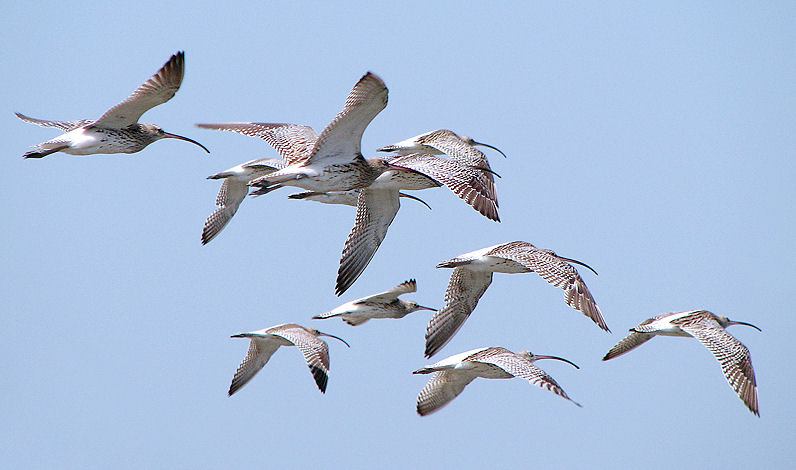
Abb.: कुरराः । Numenius arquata Linnaeus, 1758 - Eurasian Curlew - Großer
Brachvogel, Mangalore - ಮಂಗಳೂರು, Karnataka
[Bildquelle: wildxplorer. --
http://www.flickr.com/photos/krayker/3087839763/. -- Zugriff am 2010-12-22.
-- Creative Commons
Lizenz (Namensnennung)]

उत्क्रोशः ।
Klicken! Balzruf von Numenius arquata Linnaeus, 1758 - Eurasian Curlew -
Großer Brachvogel
[Quelle der .ogg-Datei: Guido Gerding / Wikimeadia. -- GNU FDLicense]
|
"Habitat. Throughout most parts of Europe,
India, Burmah, Ceylon, N. Africa, Egypt, Abyssinia and Palestine. Common along
the sea coast and backwaters in great numbers during winter; also along the
banks of the Indus and Punjab rivers, and on all large inland sheets of water."
[Quelle: Murray, James A.:
The avifauna of British India and its dependencies. -- London : Trübner,
1888-1890. -- 2 Bde. -- Bd. 2, S. 630f.] |
|
"The Curlew is found throughout India, most
abundantly perhaps near the sea coast, but also far inland,
frequenting marshes, lakes, and rivers. It is generally seen in
small flocks, often alone, but at the times of its arrival or departure
sometimes in great numbers. It arrives in September and leaves
in March or April. It is a very wary bird, and has a fine wild
whistle. It is excellent eating. It breeds in Northern Europe and Asia
(spreading in winter into Africa and Southern Asia,) laying
four eggs of the usual blotched green colour. The Curlew is
stated to perch on trees occasionally in Northern Europe."
[Quelle: Jerdon,
T. C. (Thomas Claverhill) <1811-1872>: The birds of India. --
Calcutta, 1862. -- Vol 2,2. -- S. 684.] |
Chroicocephalus ridibundus Linnaeus, 1766 - Black-headed Gull -
Lachmöwe
38 cm
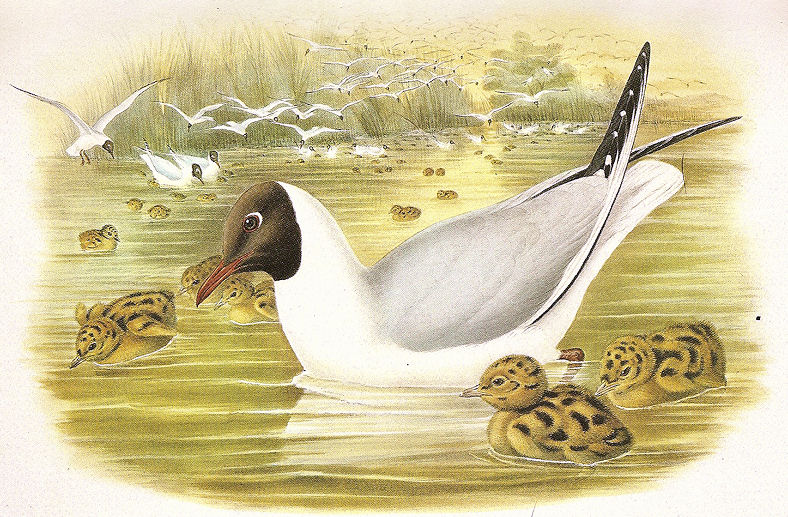
Abb.: उत्क्रोशाः । Chroicocephalus ridibundus Linnaeus, 1766 - Black-headed Gull -
Lachmöwe
[Bildquelle: Gould, Birds of Great Britain, 1862 - 1873]
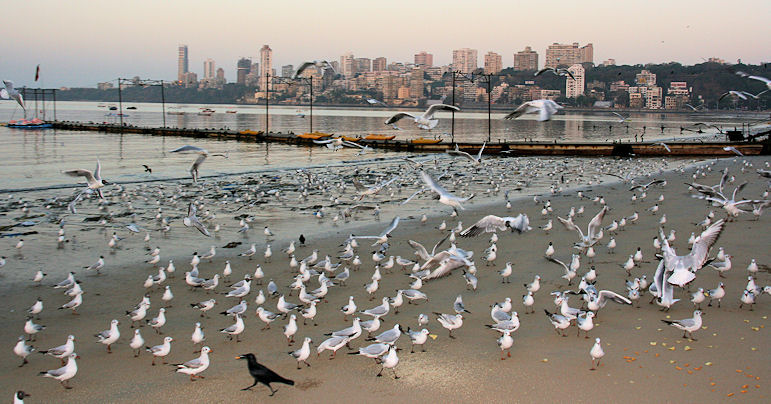
Abb.: उत्क्रोशाः । Chroicocephalus ridibundus Linnaeus, 1766 - Black-headed Gull -
Lachmöwe und Chroicocephalus brunnicephalus Jerdon, 1840 - Brown-headed
Gull - Braunkopf-Lachmöwe, Mumbai -
मुंबई, Maharashtra
[Bildquelle: Dr. S. Natarajan / Wikimedia. -- Public domain]
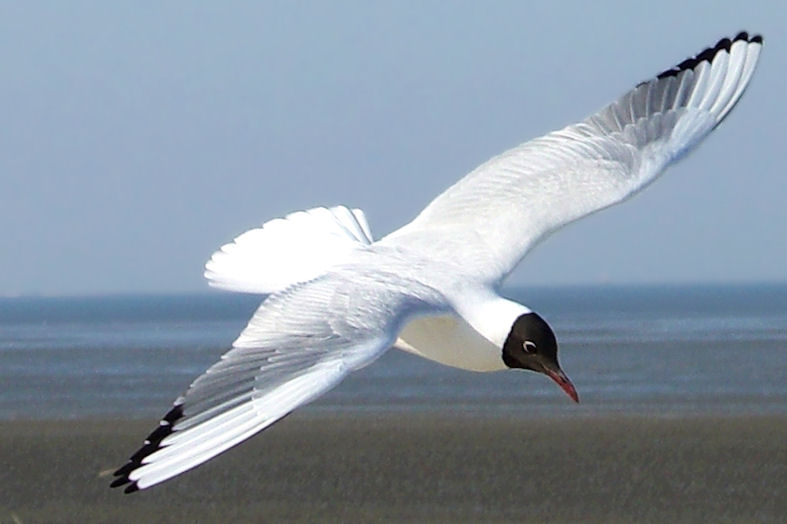
Abb.: उत्क्रोशः । Chroicocephalus ridibundus Linnaeus, 1766 - Black-headed Gull -
Lachmöwe, Deutschland
[Bildquelle: AxelHH / Wikipedia. -- Public domain]
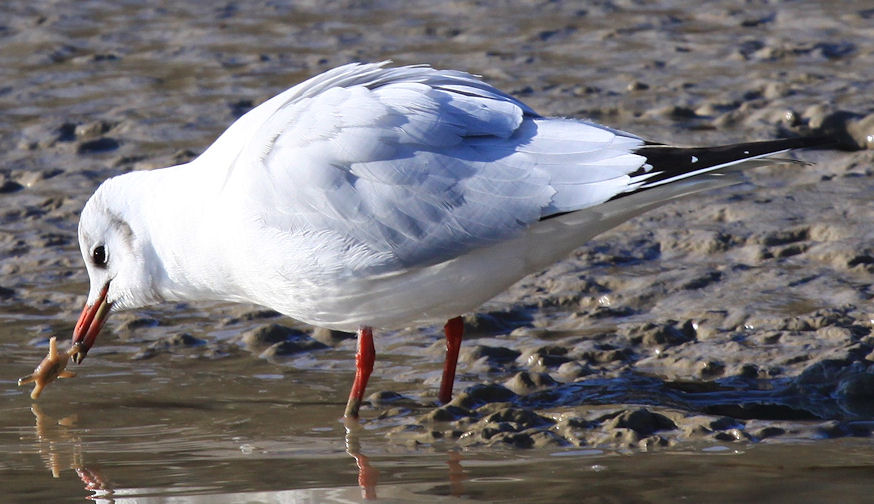
Abb.: उत्क्रोशः । Chroicocephalus ridibundus Linnaeus, 1766 - Black-headed Gull -
Lachmöwe, Frankreich
[Bildquelle: Jean-Pierre Bazard / Wikipedia. -- GNU FDLicense]
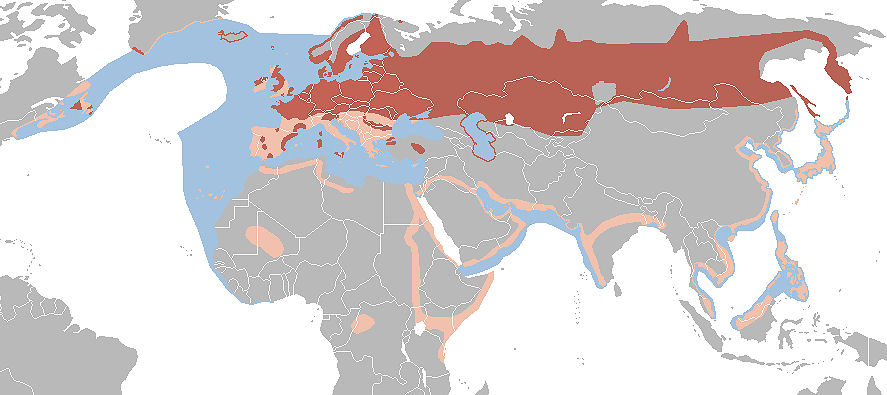
Abb.: उत्क्रोशः । Lebensräume von Chroicocephalus ridibundus Linnaeus, 1766 -
Black-headed Gull - Lachmöwe (dunkelrot = Brutgebiet; orange und blau: Vorkommen
nur im Winter)
[Bildquelle: Viktor Kravtchenko (Виктор Кравченко) / Wikipedia. -- GNU
FDLicense]
|
"Habitat. Sind, in the Kurrachee harbour, and on
the inland lakes ; the Mekran Coast, Persian Gulf, rivers of the Punjab and
Bengal, at Bombay, also the Mediterranean Coast to Egypt, Asia Minor, the
Red Sea and Arabian Coast."
[Quelle: Murray, James A.:
The avifauna of British India and its dependencies. -- London : Trübner,
1888-1890. -- 2 Bde. -- Bd. 2, S. 718.] |
|
"The Laughing Gull is not so common as the
last species, but it is found in the Bay of Bengal, and at the mouths
of the Ganges and the Hooghly in considerable numbers. It appears
to be less common in the South of India, where I never observed
it. This Gull is stated by Adams to breed on the lakes of
Ladakh.
The Laughing Gull inhabits temperate and
Northern Europe and Asia, breeding abundantly in Britain, and, in
company with the common Gull, often feeding on ploughed lands.
The eggs are said to be nearly as good as those of Plovers. The
note is a hoarse cackle compared by some to a laugh ; hence its specific
name."
[Quelle: Jerdon,
T. C. (Thomas Claverhill) <1811-1872>: The birds of India. --
Calcutta, 1862. -- Vol 2,2. -- S. 833.] |
Chroicocephalus brunnicephalus Jerdon, 1840 -
Brown-headed Gull - Braunkopf-Lachmöwe
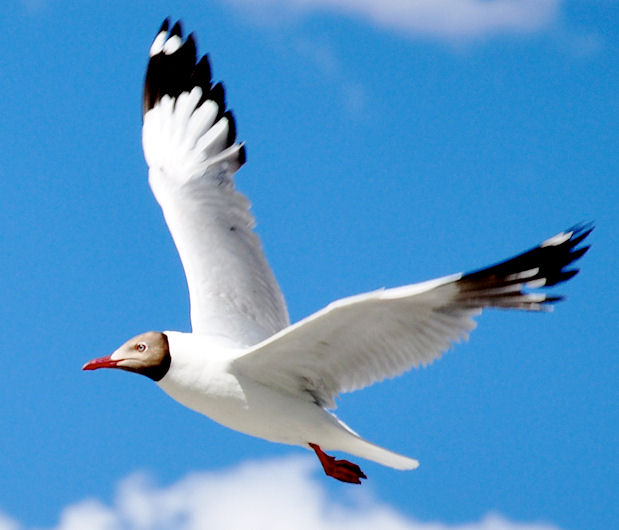
Abb.: उत्क्रोशः । Chroicocephalus brunnicephalus Jerdon, 1840 - Brown-headed Gull -
Braunkopf-Lachmöwe, Pangong Lake, Ladakh
[Bildquelle: Praveenpn
|
"Habitat. Sind, along the coast
and inland, Mekran Coast, Persian Gulf, Bengal, Kutch, Guzerat and
the Deccan. Occurs also in Burma and Ceylon."
[Quelle: Murray, James A.:
The avifauna of British India and its dependencies. -- London : Trübner,
1888-1890. -- 2 Bde. -- Bd. 2, S. 717.] |
|
"This Gull is very abundant throughout the
whole of India, frequenting the sea coasts and ascending rivers for many
miles ; it is often found also in large lakes. It has the
usual habits of its tribe, and frequently follows ships for miles to
pick up any garbage that may be thrown overboard. Occasionally, but
not often, I have seen it feeding in newly ploughed fields and in
marshes. It does not, that I know of, breed here ; its nidificaton
indeed is unknown, but probably is in Cashmere and parts of Central Asia."
[Quelle: Jerdon,
T. C. (Thomas Claverhill) <1811-1872>: The birds of India. --
Calcutta, 1862. -- Vol 2,2. -- S. 832.] |
Sterna aurantia Gray, 1831 - River Tern - Hindu-Seeschwalbe
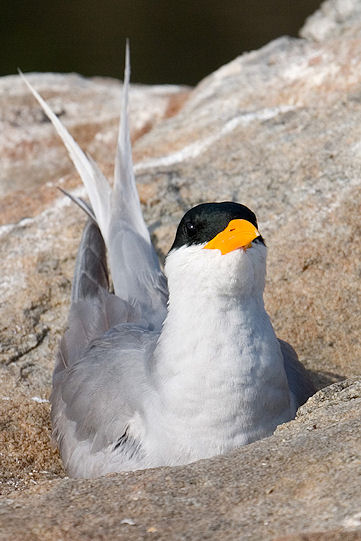
Abb.: उत्क्रोशः । Sterna aurantia Gray, 1831 - River Tern - Hindu-Seeschwalbe,
Ranganathittu Bird Sanctuary - ರಂಗನತಿಟ್ಟು ಪಕ್ಷಿಧಾಮ,
Karnataka
[Bildquelle:
Ananda Debnath. --
http://www.flickr.com/photos/heizenberg/93895622/. -- Zugriff am 2010-12-22.
-- Creative
Commons Lizenz (Namensnennung, keine kommerzielle Nutzung, keine
Bearbeitung)]
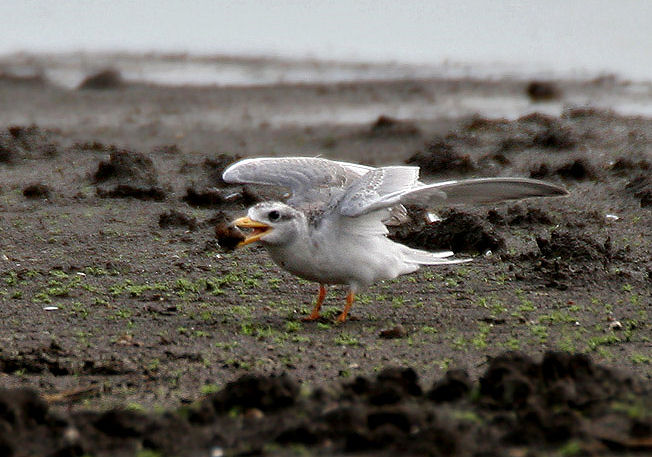
Abb.: उत्क्रोशः । Sterna aurantia Gray, 1831 - River Tern - Hindu-Seeschwalbe,
Pocharam Lake, Andhra Pradesh
[Bildquelle: J. M. Garg / Wikimedia. -- GNU FDLicense]
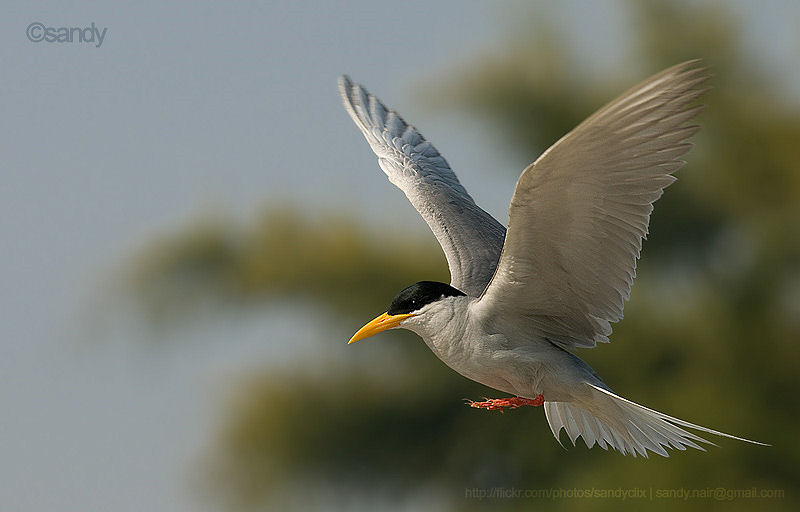
Abb.: उत्क्रोशः । Sterna aurantia Gray, 1831 - River Tern - Hindu-Seeschwalbe,
Ranganathittu Bird Sanctuary - ರಂಗನತಿಟ್ಟು ಪಕ್ಷಿಧಾಮ,
Karnataka
[Bildquelle:
Sandeep Somasekharan. --
http://www.flickr.com/photos/sandyclix/4340418931/. -- Zugriff am
2010-12-22. --
Creative
Commons Lizenz (Namensnennung, keine kommerzielle Nutzung, keine
Bearbeitung)]
|
"Habitat. Throughout India, Burmah and Ceylon,
also in Beloochistan and Persia. A permanent resident in Sind; affects
the river and lakes, also jheels. In Sind it breeds in June and July ; March
and April in Tenasserim, depositing three eggs in a slight depression in the sand.
Considerable numbers breed together. Eggs, various shades of buff,
streaked, blotched and spotted with brown. Size 1.5 to 1.75 inch x 1.17 to 1.32."
[Quelle: Murray, James A.:
The avifauna of British India and its dependencies. -- London : Trübner,
1888-1890. -- 2 Bde. -- Bd. 2, S. 724.] |
|
"This Tern is very common throughout the
greater part of India, chiefly frequenting rivers, but now and then
hunting over large tanks or inundated ground. It breeds on
churrs and sand-banks throughout the country, laying generally
three eggs. It hunts usually singly or in pairs, or in very small
parties, and does not congregate much.
Its geographical distribution is somewhat
limited, as it does not appear to occur out of India, including
Ceylon and Burmah, though it may perhaps be met with in the South of
China. Mr. Brooks informs me that he found a large regular
deposit of these Tern's eggs, upwards of a hundred, mixed with those
of other species and also of the Skimmer, on a sand-bank in
the Ganges. "I suppose," he writes, "that these were
laid by birds which had not time to prepare a nest.""
[Quelle: Jerdon,
T. C. (Thomas Claverhill) <1811-1872>: The birds of India. --
Calcutta, 1862. -- Vol 2,2. -- S. 839.] |
Chlidonias hybridus Pallas, 1811 - Whiskered Tern -
Weißbart-Seeschwalbe
25 cm
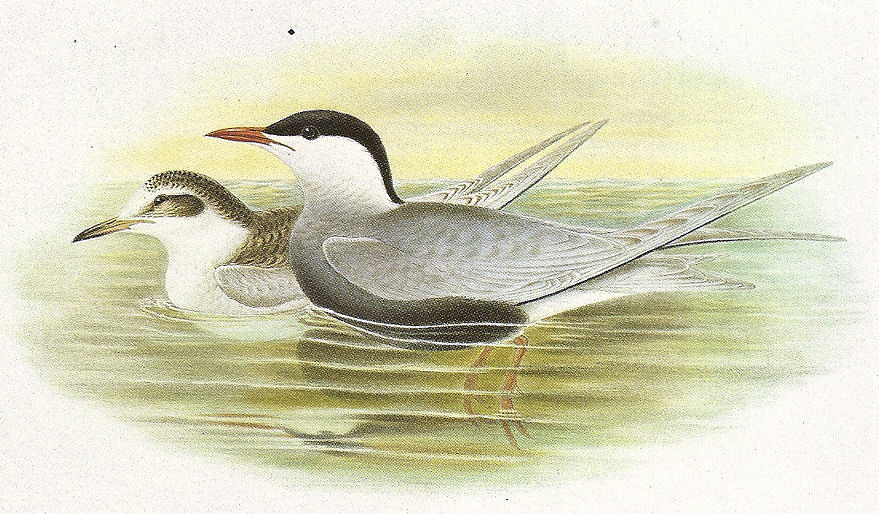
Abb.: उत्क्रोशौ । Chlidonias hybridus Pallas, 1811 - Whiskered Tern -
Weißbart-Seeschwalbe
[Bildquelle: Gould, Birds of Great Britain, 1862 - 1873]
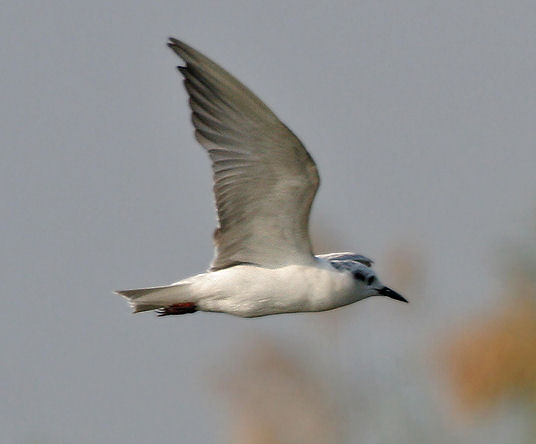
Abb.: उत्क्रोशः । Chlidonias hybridus Pallas, 1811 - Whiskered Tern -
Weißbart-Seeschwalbe, Kolleru Lake - కొల్లేరు
సరస్సు, Andhra Pradesh
[Bildquelle: J. M. Garg / Wikimedia. -- GNU FDLicense]
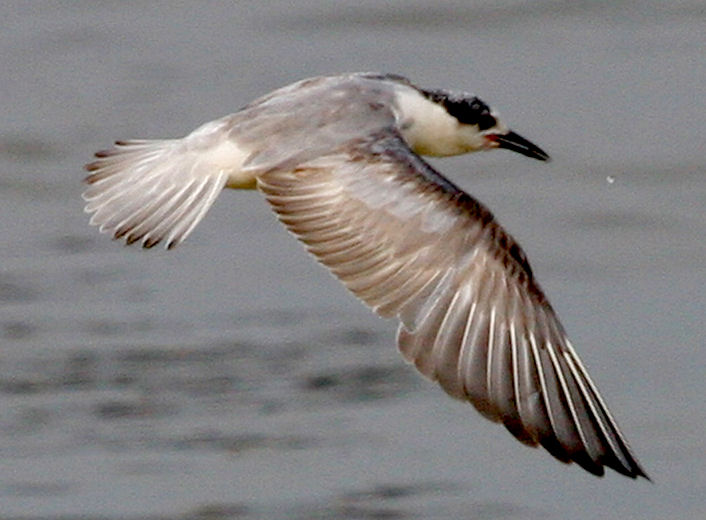
Abb.: उत्क्रोशः । Chlidonias hybridus Pallas, 1811 - Whiskered Tern -
Weißbart-Seeschwalbe, Kovalam Beach - കോവളം, Kerala
[Bildquelle: Lip Kee. --
http://www.flickr.com/photos/lipkee/986120569/. -- Zugriff am 2010-12-22.
-- Creative
Commons Lizenz (Namensnennung, share alike)]
|
"This Tern is exceedingly abundant in India,
frequenting marshes, tanks, and rivers, usually preying
on aquatic food, not unfrequently hunting over fields, beds of
reeds, and marshy ground, where it captures grasshoppers, caterpillars,
and other insects. During the night, in some parts of the
country, it roosts on thick beds of reeds, congregating in vast numbers ;
for some time after sunset, till nearly dark, indeed, it may be
seen flying in scattered flocks in an excited and hurried manner over
the surface of the water. I do not think that the birds which I
saw thus occupied were at the time engaged in capturing food.
This little Tern breeds in large churrs on the
Ganges, and probably on most other large rivers. Mr.
Brooks sent me the eggs procured near Mirzapore. It is found over the
greater part of Europe, temperate Asia, and Africa. Bonaparte
and others separate the Indian and African races from the European birds."
[Quelle: Jerdon,
T. C. (Thomas Claverhill) <1811-1872>: The birds of India. --
Calcutta, 1862. -- Vol 2,2. -- S. 837f.] |
Pandion haliaetus Linnaeus, 1758 - Osprey - Fischadler
56 cm
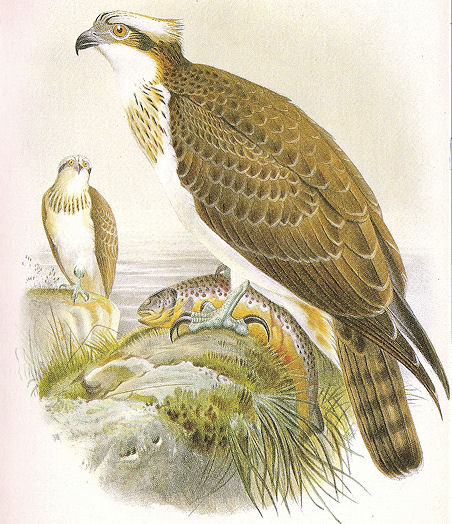
Abb.: कुररौ । Pandion haliaetus Linnaeus, 1758 - Osprey - Fischadler
[Bildquelle: Gould, Birds of Great Britain, 1862 - 1873]
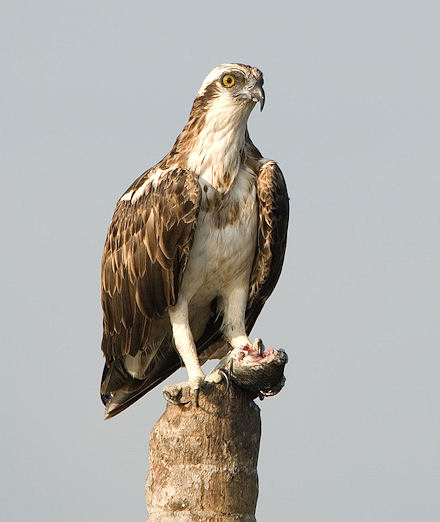
Abb.: कुररः । Pandion haliaetus Linnaeus, 1758 - Osprey - Fischadler, Goa
[Bildquelle: Sergey Yeliseev. --
http://www.flickr.com/photos/yeliseev/3087383008/. -- Zugriff am 2010-12-22.
-- Creative
Commons Lizenz (Namensnennung, keine kommerzielle Nutzung, keine
Bearbeitung)]
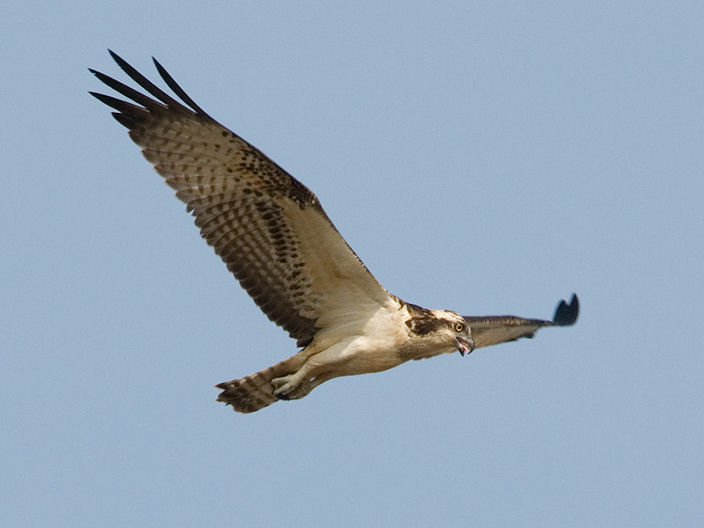
Abb.: कुररः । व्Pandion haliaetus Linnaeus, 1758 - Osprey - Fischadler, Goa
[Bildquelle: Sergey Yeliseev. --
http://www.flickr.com/photos/yeliseev/3079597228/. -- Zugriff am 2010-12-22.
-- Creative
Commons Lizenz (Namensnennung, keine kommerzielle Nutzung, keine
Bearbeitung)]
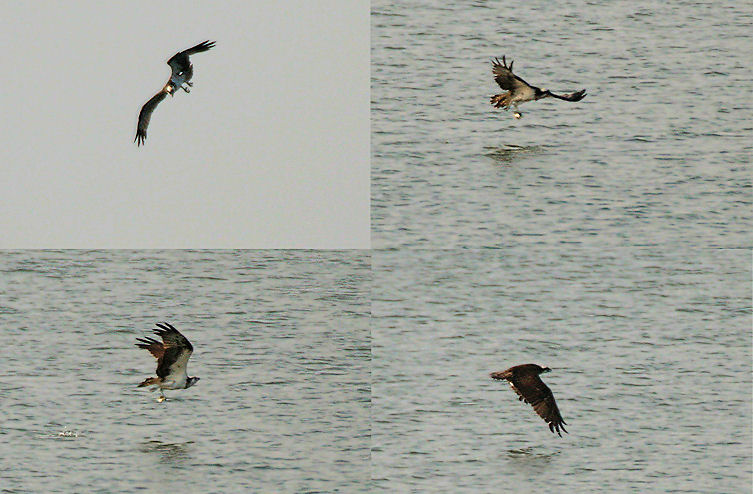
Abb.: कुररः । Pandion haliaetus Linnaeus, 1758 - Osprey - Fischadler, Kawal
Wildlife Sanctuary, Andhra Pradesh
[Bildquelle: J. M. Garg / Wikimedia. -- GNU FDLicense]
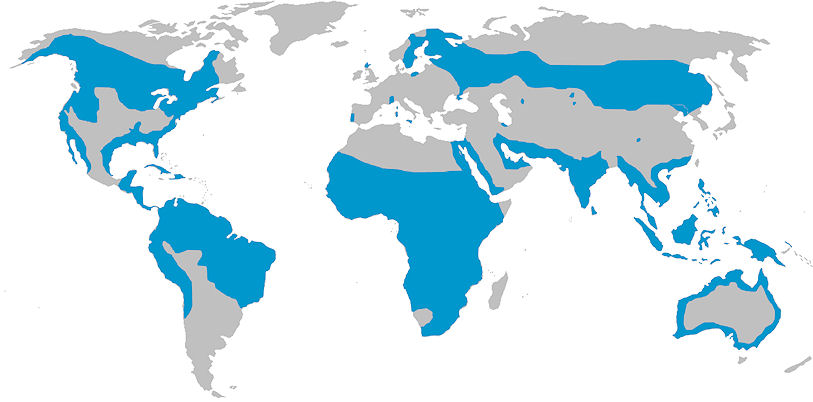
Abb.: कुररः । Lebensräume von Pandion haliaetus Linnaeus, 1758 - Osprey -
Fischadler
[Bildquelle: Zoologist / Wikipedia. -- GNU FDLicense]

कुररः । उत्क्रोशः ।
Klicken! Ruf von Pandion haliaetus Linnaeus, 1758 - Osprey -
Fischadler
[Quelle der .ogg-Datei:
http://www.nps.gov/archive/wica/Bird_List.htm / Wikimedia. -- Public domain]
|
"Habitat. Sind, Beloochistan, and Persia ; also
the Punjab, N.-W. Provinces, Bengal, British Burmah, Nepaul, Kutch,
Kattiawar, Concan and Deccan, and nearly throughout the Indian Peninsula in
suitable localities. Occurs also all over Europe and Africa, N. and S.
America, China and Japan. Very widely distributed. Most abundant along the
coasts, large rivers and lakes. In Sind it is a winter visitant.
Mr. Sharpe (Cat. Acc. p. 450) remarks that "Ospreys seem to get whiter on the head with age ; the mottling on the
breast is strongly marked in all old birds, and that the tail becomes more uniform
brown with age, so that a strongly barred tail is a sure sign of
immaturity."
It is believed the Osprey breeds in the
Valley of Kumaon, where Mr. Hume saw the nest of one, and Mr. Thompson
believes it breeds on the Ganges above Hurdwar. Nothing certain is however
known. In the British Isles it is said to make a large nest either on
trees, on rocks, or about old ruins near large pieces of water, and to lay 2 or 3
eggs, oval in form, and typically have a white ground, here and there clouded
with pale purple and very richly blotched and streaked, most densely towards
the large end with deep red, becoming in its intensity almost black. Size 2.52 X 1.89
to 1.93."
[Quelle: Murray, James A.:
The avifauna of British India and its dependencies. -- London : Trübner,
1888-1890. -- 2 Bde. -- Bd. 1, S. 81.] |
|
"The Fish-hawk of Europe is spread over all
India, most abundant of course along the coast, where there are
numerous backwaters and lagoons, but common along all the large
rivers of India, and generally found at most of the larger
lakes and tanks, even far inland. As is well known, it plunges from
a great height into the water, and bears forth a goodly-sized
fish, which its sharp claws and prickly soles enable it to carry easily,
and if too heavy to be carried with ease, it can be readily dropped,
owing to the rounded talons. It builds in this country on trees,
but I have not procured their eo-o-s, though I have seen their nests.
It is frequently robbed of its well-earned prey by the Halicetus
leucogaster. The Osprey is found over Europe, Asia, and Africa."
[Quelle: Jerdon,
T. C. (Thomas Claverhill) <1811-1872>: The birds of India. --
Calcutta, 1862. -- Vol 1. -- S. 80.] |
Haliaeetus leucogaster Gmelin, 1788 - White-bellied Fish Eagle -
Weißbauch-Seeadler
68 cm
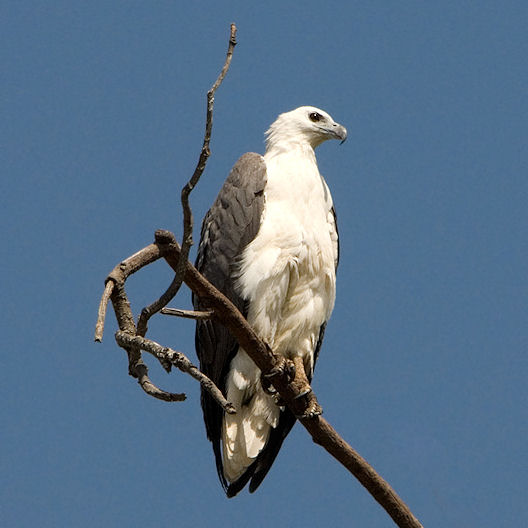
Abb.: कुररः । Haliaeetus leucogaster Gmelin, 1788 - White-bellied Fish Eagle -
Weißbauch-Seeadler, Goa
[Bildquelle: Sergey Yeliseev. --
http://www.flickr.com/photos/yeliseev/3122877783/. -- Zugriff am 2010-12-22.
-- Creative
Commons Lizenz (Namensnennung, keine kommerzielle Nutzung, keine
Bearbeitung)]
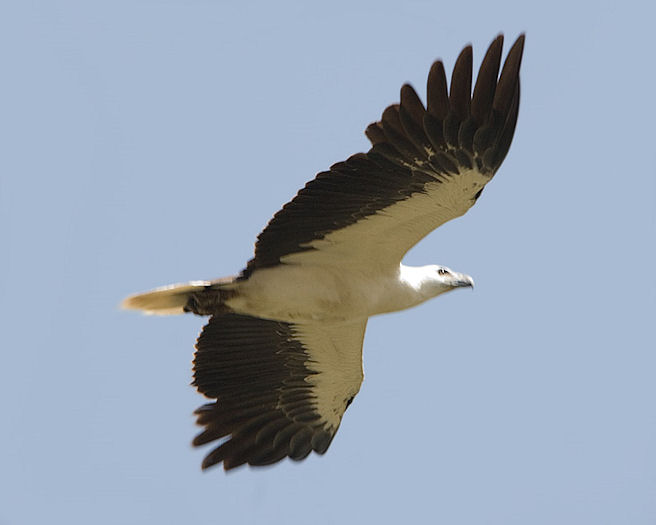
Abb.: कुररः । Haliaeetus leucogaster Gmelin, 1788 - White-bellied Fish Eagle -
Weißbauch-Seeadler, Goa
[Bildquelle: Sergey Yeliseev. --
http://www.flickr.com/photos/yeliseev/3188784566/. -- Zugriff am 2010-12-22.
-- Creative
Commons Lizenz (Namensnennung, keine kommerzielle Nutzung, keine
Bearbeitung)]
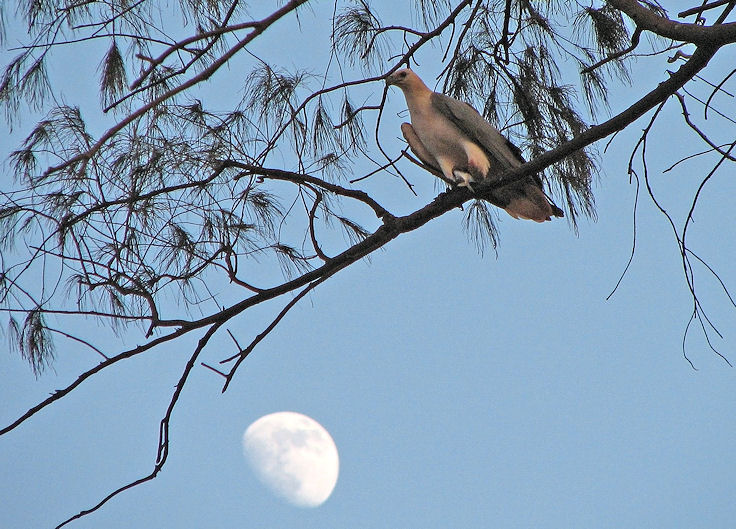
Abb.: कुररः । Haliaeetus leucogaster Gmelin, 1788 - White-bellied Fish
Eagle - Weißbauch-Seeadler, Mangalore - ಮಂಗಳೂರು,
Karnataka
[Bildquelle: wildxplorer. --
http://www.flickr.com/photos/krayker/2989019862/. -- Zugriff am 2010-12-22.
-- Creative Commons
Lizenz (Namensnennung)]
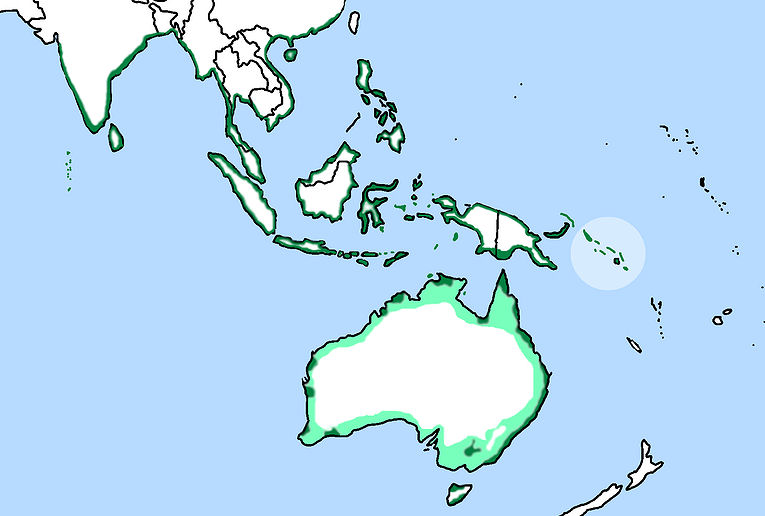
Abb.: कुररः । Lebensraum von Haliaeetus leucogaster Gmelin, 1788 - White-bellied
Fish Eagle - Weißbauch-Seeadler
[Bildquelle: Scops nach Ferguson-Lees, 2001
|
"Habitat. The whole of India, including British Burmah and the Tennaserim province, also Assam and the Malay
Archipelago, the Andamans and Nicobars. Occurs in the Concan, Deccan, Central,
Northern and Southern India, Punjab, N.-W. P. and Bengal. A permanent resident in
most parts, breeding on lofty trees.
Mr. Vidal has taken the eggs, in October,
November and December, in the Southern Concan. The nests are gigantic
platforms, built of strong, thick sticks, and are fully 5 feet in diameter. The
normal number of eggs is one, and sometimes two have been found ; they are
greenish white, unspotted and glossless, from 2.7 X 2.04 to 3 X 2.06
inches. Mr. Vidal's experience is that the same nests are used year after year,
after being repaired, and that they build on large trees in cocoanut and other
gardens. As its English name implies, it feeds chiefly upon fish."
[Quelle: Murray, James A.:
The avifauna of British India and its dependencies. -- London : Trübner,
1888-1890. -- 2 Bde. -- Bd. 1, S. 54.]
|
|
"This Sea Eagle is found over all India, but
chiefly on the coast, and for a short distance up some of the
larger rivers. It lives chiefly on sea snakes, also on fish, which it
picks up on the beach, or near the surface of the water, not diving
for them. It also eats rats, crabs, and anything living it can
catch, and will eat dead fish. It habitually preys on the osprey,
pursuing it, and robbing it of its well-earned food. The natives assert,
but probably without actual foundation, that when breeding, it
makes a larder of fresh boughs with leaves, to place the fish on, to
keep them fresh.
In Pigeon Island, 30 miles or so south of
Honore, which is well wooded with large forest trees, a whole
colony of these birds have their nests, at least thirty or forty of them
; and the ground below their nests is strewed and whitened with
bones of sea snakes chiefly, and also of fish. They breed in
December, January, and February.
This species extends through Burmah, Malayana,
and the Islands to Australia."
[Quelle: Jerdon,
T. C. (Thomas Claverhill) <1811-1872>: The birds of India. --
Calcutta, 1862. -- Vol 1. -- S. 85.] |
Haliaeetus leucoryphus Pallas, 1771 - Pallas's Fish Eagle -
Bindenseeadler
80 cm
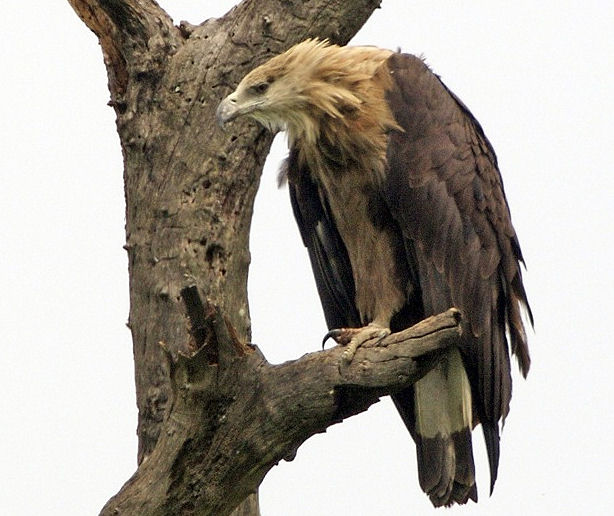
Abb.: कुररः । Haliaeetus leucoryphus Pallas, 1771 - Pallas's Fish Eagle -
Bindenseeadler, Kaziranga National Park - কাজিৰঙা
ৰাষ্ট্ৰীয় উদ্যান, Assam
[Bildquelle: Lip Kee. --
http://www.flickr.com/photos/lipkee/2478486868/. -- Zugriff am 2010-12-22.
-- Creative
Commons Lizenz (Namensnennung, share alike)]
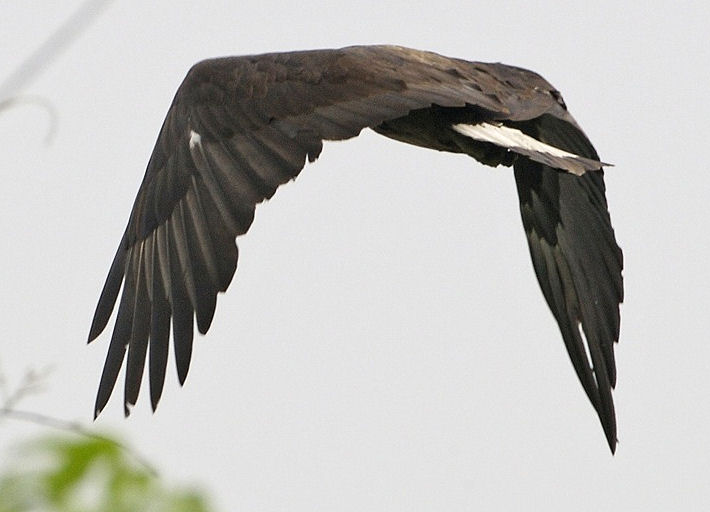
Abb.: कुररः । Haliaeetus leucoryphus Pallas, 1771 - Pallas's Fish Eagle -
Bindenseeadler, Kaziranga National Park - কাজিৰঙা
ৰাষ্ট্ৰীয় উদ্যান, Assam
[Bildquelle: Lip Kee. --
http://www.flickr.com/photos/lipkee/2439213124/. -- Zugriff am 2010-12-22.
-- Creative
Commons Lizenz (Namensnennung, share alike)]
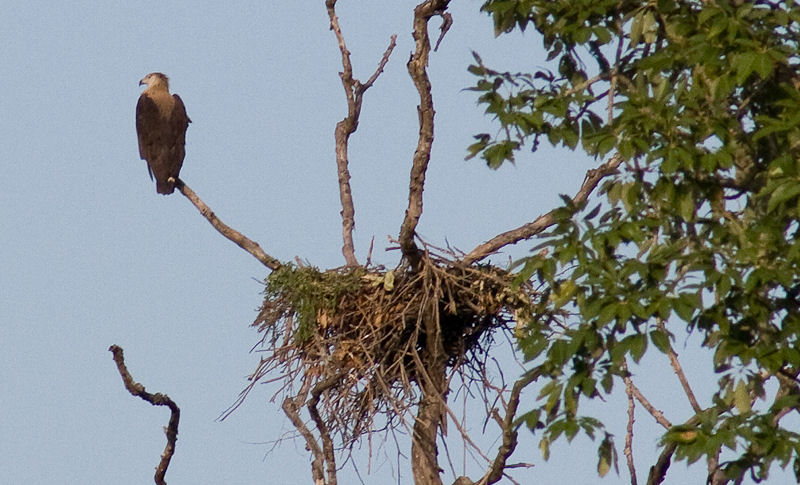
Abb.: कुररः । Haliaeetus leucoryphus Pallas, 1771 - Pallas's Fish Eagle -
Bindenseeadler, Kaziranga National Park - কাজিৰঙা
ৰাষ্ট্ৰীয় উদ্যান, Assam
[Bildquelle:
Pete Favelle. --
http://www.flickr.com/photos/ganders/4505394020/. -- Zugriff am 2010-12-22.
-- Creative
Commons Lizenz (Namensnennung, keine kommerzielle Nutzung)]
|
"Habitat. Sind, Punjab, N.-W. Provinces, Oudh
and Bengal ; Kutch, Rajputana, the Western Coast and the Cancan; also
Beloochistan, Persia and Afghanistan. Ascends the Ganges and other
large rivers ; found also in Nepal and Cashmere. In the Concan and along
the Sind, Kutch and Kattiawar Coasts, it is known as the Mutchee
Mar or Mutchlee Mung.
The Ring-tailed Sea Eagle is found throughout
the year in Sind, along the Indus., and on the larger lakes. It breeds in
the winter months (November, December and January), building a nest of
twigs, &c., from 4 to 5 feet in diameter, inclusive of the outer thin layer,
usually on high trees in the vicinity of water. Eggs usually 2, but I have found a
third and fourth laid by the same bird a fortnight after taking the two
first ones. In colour they are white or greyish white and unspotted, and measure
2 3/4 - 3 inches x 2 1/4 to 2 1/2."
[Quelle: Murray, James A.:
The avifauna of British India and its dependencies. -- London : Trübner,
1888-1890. -- 2 Bde. -- Bd. 1, S. 55.] |
|
"This fine Fish Eagle is found throughout the
North of India, most abundant in Bengal, and the countries to the
westward. It ascends the Ganges and other large rivers to some
distance, and is found in Nepal, and as far north-west as Cashmere,
where Dr. Adams has observed it on the lakes and rivers. It
is also common on the Indus. It is said to be found in the Crimea,
and to be identical with F. leucoryphus of Pallas. But Mr. Newton
on examining the sterna of H. Macei from India, and so called
leucoryphus from the Crimea, found a considerable difference
between them.—Vide Ibis, vol. 3, p. 223.
I have only seen it myself on the Ganges and
Hooghly, and a few of their tributaries. It lives chiefly on
fish, also on turtle, and snakes ; and most probably will take other
food, and often carries off a wounded duck. It does not, however,
dive for fish like the two last birds. It may often be seen seated
on the high bank, or on a sand chur in the Ganges, or in a decayed
tree near the edge of the river. It builds its nest in general
on large trees, but I have also found it building on trees not
more than 30 or 40 feet high, on the banks of the Ganges. It has a
wild clanging cry. "
[Quelle: Jerdon,
T. C. (Thomas Claverhill) <1811-1872>: The birds of India. --
Calcutta, 1862. -- Vol 1. -- S. 83f.] |
2.9.60. Anatidae - Entenvögel (Schwäne, Gänse, Enten) - Swans, Geese, Ducks
|
23. c./d. haṃsās tu śvetagarutaś cakrāṅgā mānasaukasaḥ
हंसास् तु श्वेतगरुतश् चक्राङ्ग मानसौकसः ॥२३ ख॥
[Bezeichnungen für
Anatidae - Entenvögel (Schwäne, Gänse, Enten) - Swans, Geese, Ducks:]
-
हंस -
haṃsa m.: Haṃsa = "a generic term for a large part of the Anatidae
family. Swans, Geese, Ducks." (Dave, 515)
- श्वेतगरुत्
-
śvetagarut m.: "Weiß-Flügel" = "white-winged, a Swan alone has white wing
quills:" (Dave, 428)
- चक्राङ्ग
-
cakrāṅga m.: "Wagen-Gliedrig" = "refer[s] to the circular or spiral flight of
the birds as they survey their landing ground or water, and also to the vigorous
rotary motion of their wings preparatory to settling down." (Dave, 429)
- मानसौकस्
- mānasaukas m.: "im Mānasa1 wohnend" = "All the Swans and Geese come across the
Himalayas and as the Bar-headed Geese were known to have their breeding grounds
at the Himalayan lakes including the मानसरोवर (Mānasarovara)1 the Swans also have
been placed there and the name merely signifies their northern home across the
Himalayas." (Dave, 429)
|
Colebrooke (1807): "Geese."
1 मानसौकस्
- mānasaukas m.: "im Mānasa wohnend"
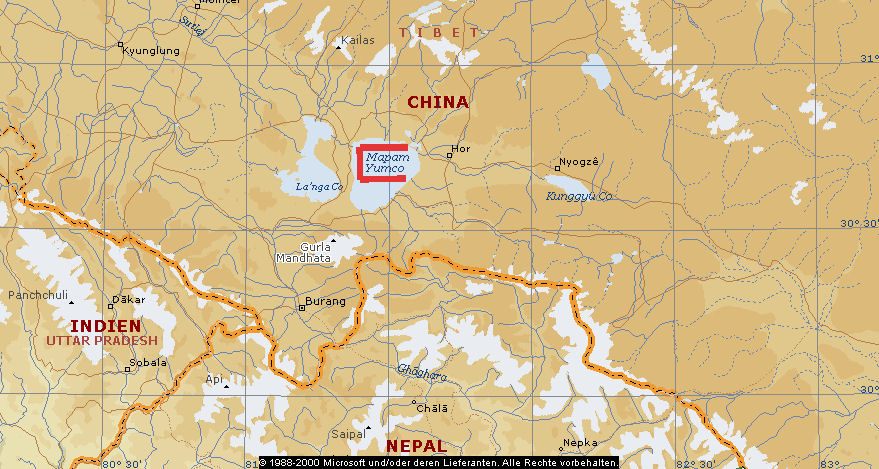
Abb.: Lage des मानसरोवरः
।
མ་ཕམ་གཡུ་མཚོ
।
Mānasasarovara
[Bildquelle: ©MS Encarta]
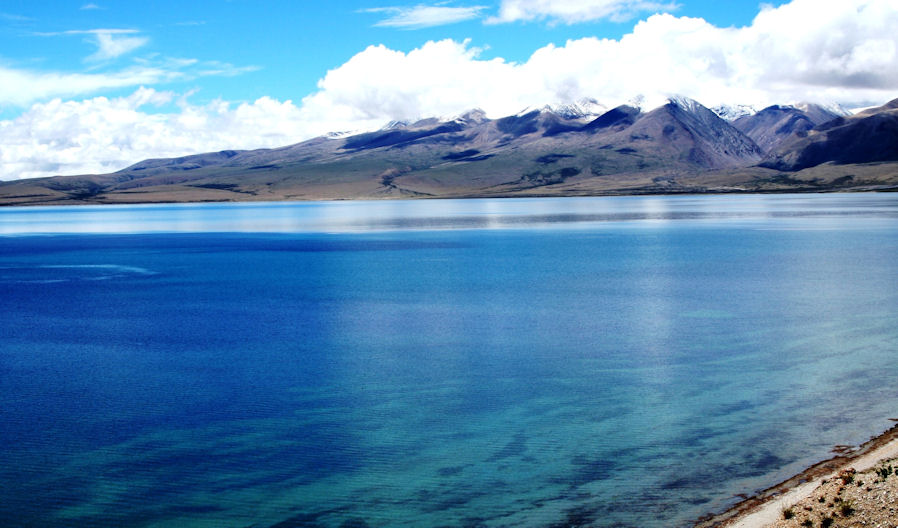
Abb.: मानसरोवरः ।
མ་ཕམ་གཡུ་མཚོ
।
Mānasasarovara
[Bildquelle: Prateek / Wikimedia. --
Creative
Commons Lizenz (Namensnennung, share alike)]
|
"MĀNASA, MĀNASA-SAROVARA. The lake Mānasa in the Himalayas. In the Vāyu Purāṇa it is
stated that when the ocean fell from heaven upon Mount Meru, it
ran four times round the mountain, then it divided into four
rivers which ran down the mountain and formed four great lakes,
Aruṇoda on the east, Sitoda on the west, Mahā-bhadra on the
north, and Mānasa on the south. According to the mythological
account, the river Ganges flows out of it, but in reality no
river issues from this lake, though the river Satlej flows from
another and larger lake called Rāvaṇa-hrāda, which lies close to the west of
Mānasa."
[Quelle: Dowson, John
<1820-1881>: A classical dictionary of Hindu mythology and
religion, geography, history, and literature. -- London, Trübner,
1879. -- s.v. ] |
| "Der See Mānasarovar, tibetisch Mapham Yutsho (མ་ཕམ་གཡུ་མཚོ)།,
befindet sich im Kreis Purang, Regierungsbezirk Ngari auf dem Dach
der Welt im Südwesten des Autonomen Gebiets Tibets in der
Volksrepublik China. Geografie
Der zwischen den Gebirgsketten Transhimalaya (im Norden) und
Himalaya (im Süden) gelegene Manasarovar ist einer der
höchstgelegenen Süßwasserseen der Welt mit einer Höhe von 4490
Metern über Normalnull. Er hat eine Wasseroberfläche von
durchschnittlich 412 km² und ist bis zu 77 Meter tief. Der See liegt
auf einer Hochebene, die durch die markanten Berge Kailash (6714 m)
und Gurla Mandhata (7728 m) eingerahmt wird.[1]
Vier große Flüsse entspringen in unmittelbarer Nähe des Sees:
- Satluj im Westen (bei Hochwasser gibt es auch eine direkte
Verbindung über die Verbindungs-Wadi Ganga Chu zwischen
Manasarovar und Rakshastal),
- Indus im Norden,
- Brahmaputra (Yarlung Zangbo) im Osten und
- Karnali im Süden.
Namen
Auf Tibetisch heißt der See Mapham Yutsho (tib.: ma pham
g.yu mtsho); der Name bedeutet "unbesiegbarer Türkis-See". Die
chinesische Bezeichnung Mǎpáng Yōngcuò 玛旁雍错 (auch: Mǎfǎ
Mùcuò 玛法木错) ist aus dem Tibetischen entlehnt. Weitere tibetische
Namen für den See sind Tshochen Mapham Yutsho, Tsho Mapham,
Tsho Rinpoche, Pema Lhatsho und ("göttlicher
Lotos-See"). "Manasarovar" ist Sanskrit, zusammengesetzt aus
manas "Geist" und sarovar "See"; eine weiterer
Sanskrit-Name ist Anavatapta.
Der See wird "unbesiegbar" bzw. "unübertroffen" genannt, weil nur
sein Wasser die "Acht Eigenschaften perfekten Wassers" besitzen
soll: kühl, süß, leicht, weich, klar, rein, weder Magen noch Hals
reizend. Er heißt auch "ewig kühl", weil der Wassergott (naga)
Anavatapta (Pali: Anotatta, Tibetisch: Mazhoiba; "der sich
niemals erhitzt") hier leben soll. Die Bezeichnung "göttlicher
Lotos-See" geht auf einen Vergleich seiner Wasserfläche mit einer
geöffneten Lotosblüte zurück.
Religiöse Bedeutung
Der Manasarovar ist ein Heiligtum der Hindus und der Buddhisten
und so auch wichtiges Ziel von Pilgern. Er zählt zu den drei
heiligen Seen in Tibet. Nach der hinduistischen Mythologie wurde der
See vom Gott Brahma erdacht ("manas"). Im hinduistischen Epos
Ramayana heißt es:
- »Wann immer einer den Boden um den Manasarovar berührt
oder wenn er in dem See badet, so wird er ins Paradies des
Brahma eingehen; und der, der von seinen Wassern trinkt, wird in
Shivas Himmel eingehen und wird von den Sünden von hundert
Wiedergeburten erlöst werden.«
Entlang des Seeufers befanden sich früher entsprechend der acht
Speichen des buddhistischen Lebensrads die Gompas (Klöster) Chiu
(auf einem Felsen gebaut), Cherkip, Langpona, Bönri, Seralung,
Yerngo, Trügo und Gösul, von denen fünf noch existieren. Der Rundweg
auf dem traditionellen Pilgerweg misst 103 km (Manasarovar Parikrama),
für den die Pilger zwischen zwei und vier Tagen benötigen.[2]
Während in der Mystik mit dem Manasarovar die Attribute leicht,
positiv und männlich verbunden werden, sind dies beim westlichen
Nachbarn Raksastal die Attribute dunkel, negativ und weiblich. Da
die beiden Seen von den Tibetern auch als Bräutigam und Braut
angesehen werden, wird es als glücksverheißend angesehen, wenn der
Verbindungskanal Ganga Chu Wasser führt.[3]
Sonstiges
Der See ist Namensgeber des Bollywood-Films Wiedersehen am
See Manasarovar, Anup Kurian (2004).
Manasarovar ("Ozean der Gedanken") lautet des weiteren der
Titel einer Sammlung von 205 der insgesamt etwa 350 Kurzgeschichten
des indischen Schriftstellers Premchand (1880-1936)."
[Quelle:
http://de.wikipedia.org/wiki/Manasarovar. -- Zugriff am
2011-01-19] |
Schwäne kommen nur ganz gelegentlich in Indien vor!
Schwäne: siehe den nächsten Vers
Gänse: siehe Vers 22c - 23a
Hier einige Beispiele von Enten (meist Anas sp.)
Anas acuta Linnaeus, 1758 - Northern Pintail - Spießente
57 - 74 cm
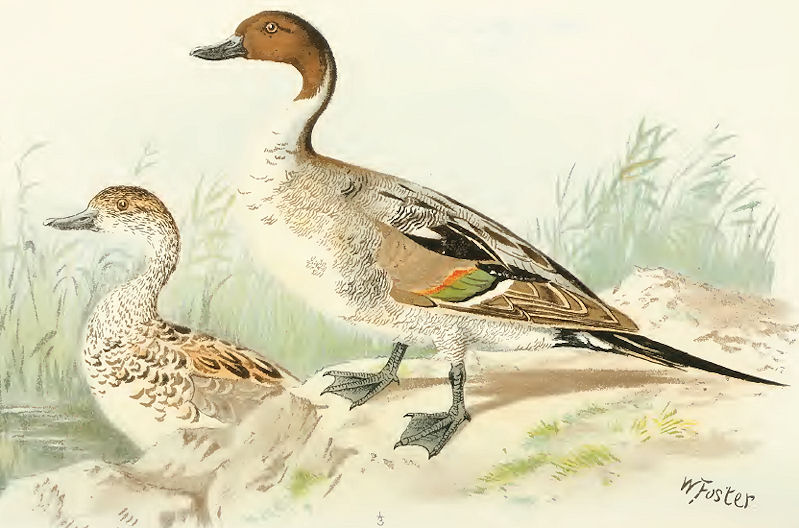
Abb.: हंसौ ! Anas acuta Linnaeus, 1758 - Northern Pintail - Spießente
[Bildquelle: Indian sporting birds. -- 1915.]

हंसः ।
Klicken! Ruf von Anas acuta Linnaeus, 1758 - Northern Pintail - Spießente
[Quelle der .ogg-Datei:
http://www.nps.gov/archive/wica/Bird_List.htm / Wikimedia. -- Public domain]
|
"Habitat. Sind, Beloochistan, Persia, Afghanistan,
Punjab, N.-W. and Central Provinces, Oudh, Bengal, Kutch, Concan,
Deccan, Guzerat, Central and Southern India and Ceylon. Hume says "There
is no district in the Empire, from Ceylon to Kashmir, and from
Kashmir to Sadya, Munipoor and Moulmein, where the Pintail does not occur in
greater or less abundance except in south Tenasserim."
The Pintail affects the large broads or
dhunds and lakes, and is seldom seen except in large parties. It is held in
much esteem for the table, and for this purpose is netted in great numbers
with the Gadwall and other water birds. On the Munchur Lake the fowlers net
from 100 to 200 daily, and a sportsman in suitable localities could obtain
two or three dozens at least as a good day's sport, besides other game. Hume,
like myself, thinks that on the whole, next to the Mallard, the Pintail is
the best duck for the table in India, the Gadwall ranking third."
[Quelle: Murray, James A.:
The avifauna of British India and its dependencies. -- London : Trübner,
1888-1890. -- 2 Bde. -- Bd. 2, S. 690f.] |
|
"The Pintail is one of the most numerous
winter visitants to India in the present sub-family, frequenting
large tanks and jheels, often in immense flocks, and flying with
great rapidity. Its long brown neck and lengthened tail causes it
to be readily distinguished when in flight. Its call is soft and subdued,
and it is by no means garrulous. Few Ducks are brought to
the different markets for sale in such abundance as this species,
and it is very excellent eating. Like most of the Ducks, it has a wide
geographical distribution throughout both Continents, and
breeds in northern regions, laying eight or ten bluish-white eggs."
[Quelle: Jerdon,
T. C. (Thomas Claverhill) <1811-1872>: The birds of India. --
Calcutta, 1862. -- Vol 2,2. -- S. 804.] |
Anas crecca Linnaeus, 1758 - Common Teal - Krickente
38 cm
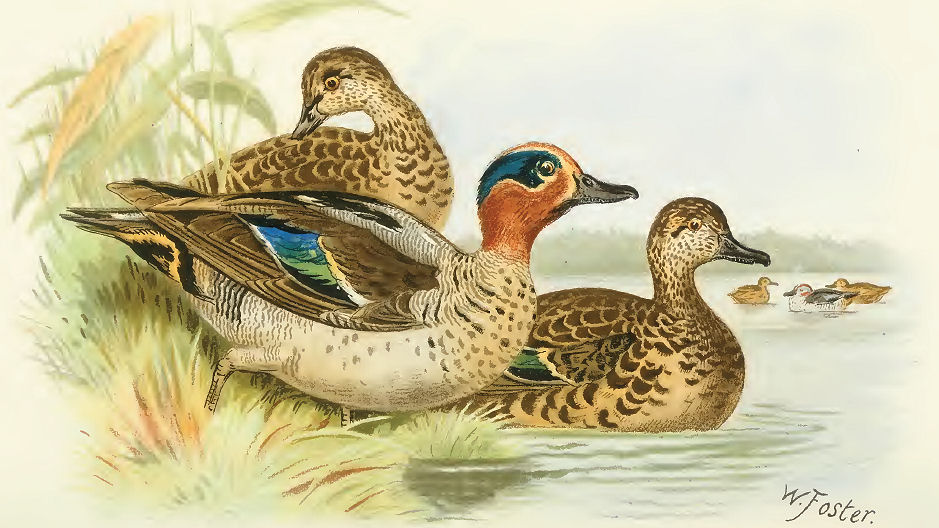
Abb.: हंसाः । Anas crecca Linnaeus, 1758 - Common Teal - Krickente
[Bildquelle: Indian sporting birds. -- 1915.]
|
"Habitat. Sind, Beloochistan, Persia, Afghanistan,
Punjab, N. W and Central Vovinces, Rajputana, Kutch and throughout
India and Burmah.
Abundant wherever it occurs, frequenting tanks, rivers,
ponds and jheels, &c."
[Quelle: Murray, James A.:
The avifauna of British India and its dependencies. -- London : Trübner,
1888-1890. -- 2 Bde. -- Bd. 2, S. 693.]
|
|
"The well known Teal is one of the most
abundant as well as the earliest of the visitors to India. I have
seen it early in September, and it is late before it leaves the country.
It frequents both tanks and rivers, often in immense
flocks, and its flight is amazingly rapid. Large numbers are netted or
caught in various ways to supply the Tealeries. It is a
strictly night-feeding species, and about sunset flocks may be seen and heard
flying in different directions to their feeding grounds. Its
geographical distribution is similar to that of most of the Ducks of
this sub-family, and it breeds in northern and temperate regions."
[Quelle: Jerdon,
T. C. (Thomas Claverhill) <1811-1872>: The birds of India. --
Calcutta, 1862. -- Vol 2,2. -- S. 807.] |
Anas strepera Linnaeus, 1758 - Gadwall - Schnatterente
51 cm
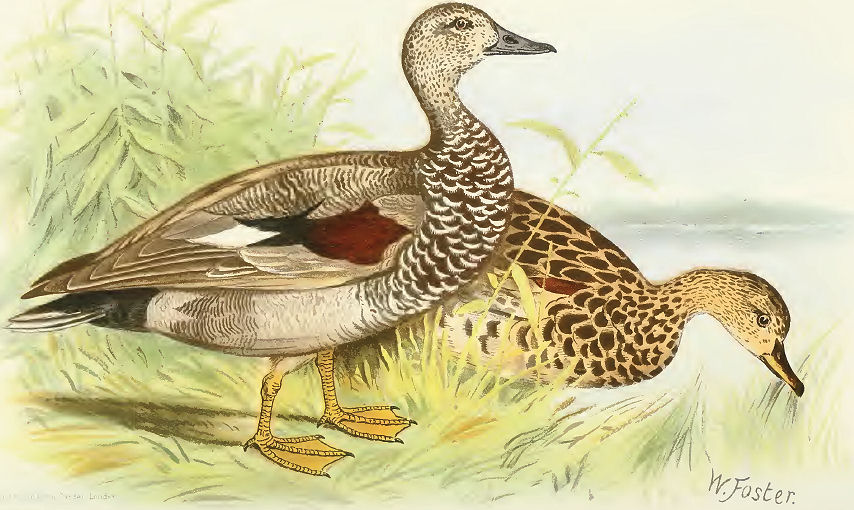
Abb.: हंसौ । Anas strepera Linnaeus, 1758 - Gadwall - Schnatterente
[Bildquelle: Indian sporting birds. -- 1915.]
|
"Habitat. Central and South Europe, and nearly
throughout India ; found in Sind, Beloochistan, Afghanistan, and Persia;
also in the Punjab, N.-W. and Central Provinces, Oudh, Bengal, Central
India, Kutch, Guzerat, the Concans and Deccan; recorded also from Nepaul, Gilgit,
and E. Turkestan; it is also let with on the Continent of Europe, in Spain
and Italy, also in Iceland and Liberia, as well as in the northern parts of
Africa and India generally. In Sind it is numerous on the lakes, dhunds,
&c., during winter, and especially in the Munchur, arriving about the middle of
November.
Gadwall are considered excellent for the
table, especially during the first two months of their arrival, when they usually
feed on rice and young shoots of the sprouting wheat crops. Later on they
affect the jheels and feed on Crustaceans and fry of fish, and though then
rather fishy in taste, the flesh is not despised when better game is not to be
had. The localities preferred by the Gadwall after dusk are generally lakes,
jheels and ponds covered with long herbage, but during the day it frequents open water, as
the broads of the Indus."
[Quelle: Murray, James A.:
The avifauna of British India and its dependencies. -- London : Trübner,
1888-1890. -- 2 Bde. -- Bd. 2, S. 687.] |
|
"The Gadwall is by no means a rare bird in any
part of India, in the cold weather, generally frequenting
the more open and larger tanks in moderately large parties. Its flight
is rapid, and its voice not unlike that of the common Duck. It is
found over the greater part of the Old Continent, and also in
America. It is justly considered one of the best wild Ducks for the
table. No other species of Gadwall is recorded."
[Quelle: Jerdon,
T. C. (Thomas Claverhill) <1811-1872>: The birds of India. --
Calcutta, 1862. -- Vol 2,2. -- S. 802.] |
Anas penelope Linnaeus, 1758 - Eurasian Wigeon - Pfeifente
49 cm
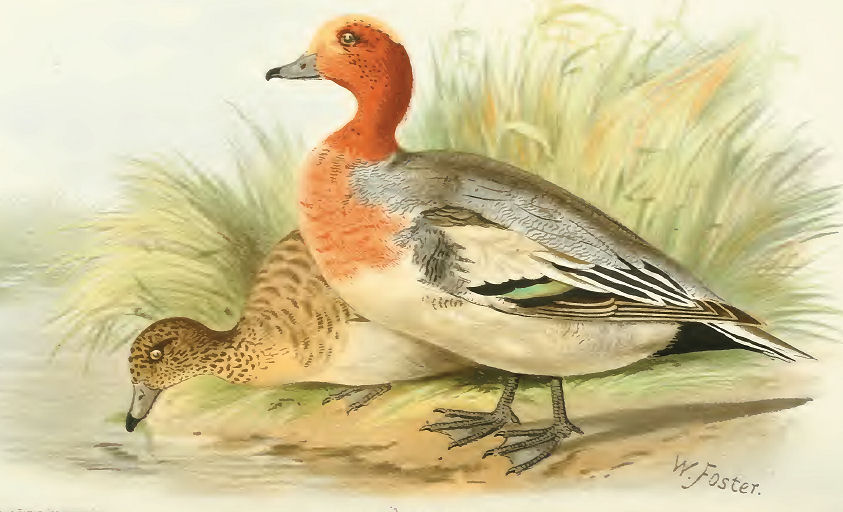
Abb.: हंसौ । Anas penelope Linnaeus, 1758 - Eurasian Wigeon - Pfeifente
[Bildquelle: Indian sporting birds. -- 1915.]
|
"Habitat. Sind, Beloochistan, Persia, Afghanistan,
Punjab, N.-W. and Central Provinces, Oudh, Bengal and throughout
Western and Central India, rare in Southern India and Burmah, and not yet
recorded from Ceylon. In Kattiawar, Rajputana, the Deccan and Concan it is not
uncommon during the winter months. It is considered excellent eating for
the first two months after arrival, but after this the flesh is said to become of a muddy
flavour and unpalatable."
[Quelle: Murray, James A.:
The avifauna of British India and its dependencies. -- London : Trübner,
1888-1890. -- 2 Bde. -- Bd. 2, S. 692.] |
|
"The Wigeon cannot be said to be either common
or abundant in India, although it is met with
occasionally in every part of the country, in small or moderate flocks. It has
a peculiar shrill whistling call chiefly heard during flight. Its
geographical distribution is over the northern and temperate regions of
the Old Continent. It breeds far north, and, though very
abundant in Britain, is only a winter visitant there."
[Quelle: Jerdon,
T. C. (Thomas Claverhill) <1811-1872>: The birds of India. --
Calcutta, 1862. -- Vol 2,2. -- S. 805.] |
Anas querquedula Linnaeus, 1758 - Garganey - Knäkente
41 cm
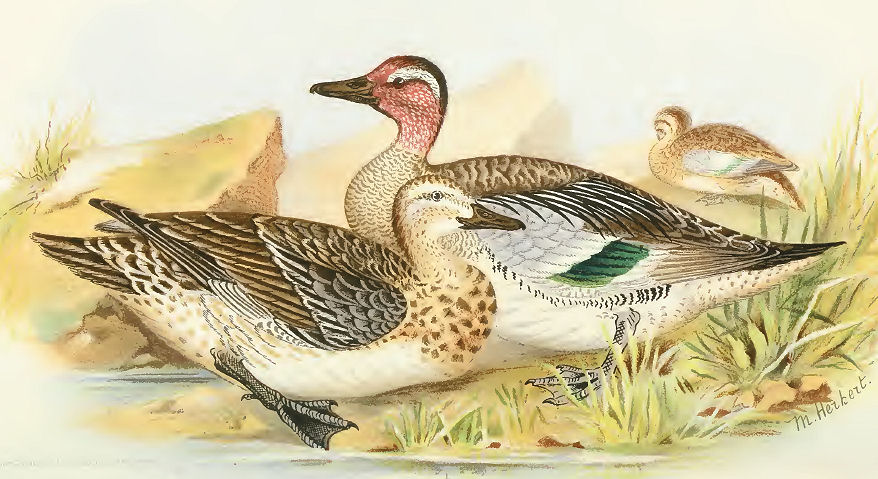
Abb.: हंसाः । Anas querquedula Linnaeus, 1758 - Garganey - Knäkente
[Bildquelle: Indian sporting birds. -- 1915.]
|
"Habitat. The same as Q. crecca.
Not found in as great numbers as Q. crecca,
affects the same situations, and is considered excellent for the table. It is
chiefly a nocturnal feeder, concealing itself in the jheels and dhunds, among the
high grass, during the day; when disturbed it usually returns to the same
spot. Hume says "that at nights they come in some parts of the country
in such crowds into paddy fields as to destroy acres of crop at one visit ;
their food, like Q. crecca, is chiefly vegetable, as tender shoots and leaves of
water plants, seeds, bulbs, &c., but on the sea coasts, especially the Sind and
Mekran Coast, where they are frequently found in some numbers, Crustacea,
slugs, fry of fish and algae form their diet.""
[Quelle: Murray, James A.:
The avifauna of British India and its dependencies. -- London : Trübner,
1888-1890. -- 2 Bde. -- Bd. 2, S. 694.] |
|
"The Blue-winged or Garganey Teal is, perhaps,
still more abundant in India, than the common Teal, but is
somewhat later in its arrival here. It occurs in vast flocks,
feeding at night chiefly, and has a swift flight. Like the last,
numbers are caught and fed throughout the summer in our Tealeries,
and both this and the last are most excellent food. The Garganey
Teal does not extend to America, but is distributed over the
greater portion of the Old Continent.
I have once or twice procured birds with the
whole head, neck, and under parts, deep ferruginous, but I
consider this to be an individual variation.
Vast quantities of this and the previous
species are annually caught alive, some by large flap-nets, others
by nooses fixed to a long line across a jheel; and in some places,
by a man wading with his head above water concealed in a
large earthen chatty, several of which have previously been set afloat."
[Quelle: Jerdon,
T. C. (Thomas Claverhill) <1811-1872>: The birds of India. --
Calcutta, 1862. -- Vol 2,2. -- S. 808.] |
Anas clypeata Linnaeus, 1758 - Northern Shoveler - Löffelente
51 cm
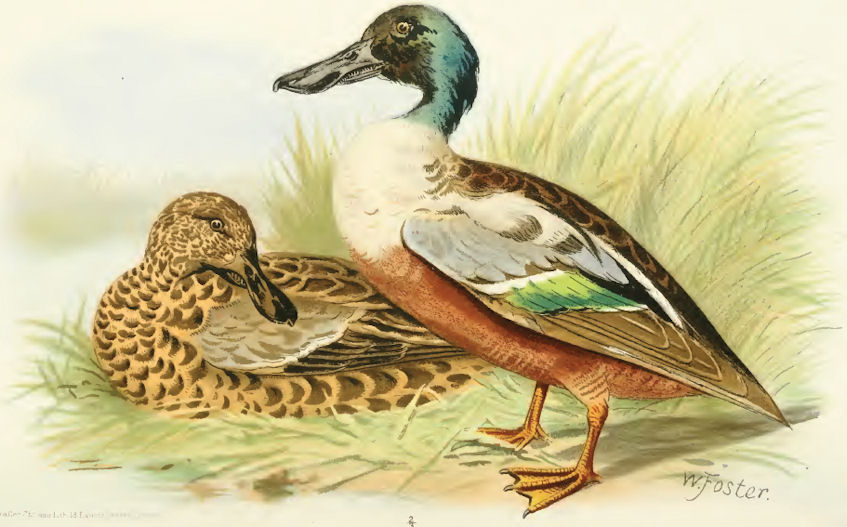
Abb.: हंसौ । Anas clypeata Linnaeus, 1758 - Northern Shoveler - Löffelente
[Bildquelle: Indian sporting birds. -- 1915.]
|
"Habitat. Sind, Belochistan, Persia, Afghanistan,
Nepaul, Cashmere, Eastern Turkestan, Punjab, N -W. Provinces and Oudh,
Bengal, Central India, Rajputana, Kutch, Guzerat, Concan, Deccan,
South India, and Ceylon.
Winter visitors to India, affecting all the
lakes, marshes, ponds, &c., feeding on worms, larvae, tadpoles, seeds, and young
shoots of aquatic plants.
They are not naturally shy, as in village
ponds they are frequently seen dabbling about, or standing in the shallow edge of
ponds, while the inhabitants are drawing water or bathing."
[Quelle: Murray, James A.:
The avifauna of British India and its dependencies. -- London : Trübner,
1888-1890. -- 2 Bde. -- Bd. 2, S. 683.] |
|
"The Shoveller is found throughout India in
the cold weather in small parties, often mixed with Gadwalls and
other species ; feeding near the edges of tanks in shallow water among
weeds, chiefly on minute worms and larvae, which it sifts from
the mud. It is often late in leaving this country. It is found
over both Continents, breeding, in temperate as well as in northern
regions, in marshes, and laying ten to twelve oil-green eggs. The
intestines of this Duck are very long, from 9 to 10 feet."
[Quelle: Jerdon,
T. C. (Thomas Claverhill) <1811-1872>: The birds of India. --
Calcutta, 1862. -- Vol 2,2. -- S. 797.] |
Aythya nyroca Güldenstädt, 1770 -
Ferruginous Pochard - Moorente
41 cm
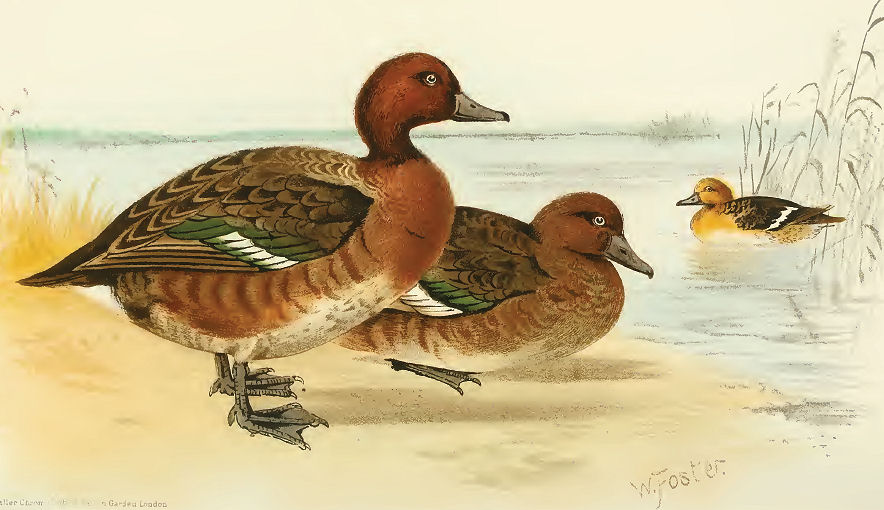
Abb.: हंसाः । Aythya nyroca Güldenstädt, 1770 - Ferruginous
Pochard - Moorente
[Bildquelle: Indian sporting birds. -- 1915.]
|
"Habitat. Sind, Beloochistan, Persia, Afganistan
and throughout India, except South India and Ceylon. Occurs in Nepaul,
Gilgit and Eastern and Western Turkistan, in which latter it breeds. In the
lakes of Cashmere, Hume says, "they breed most abundantly, and that
boat-loads of their eggs are brought to market at Srinuggar." The White Eye affects
chiefly jheels with thick cover, where they sport about in the early morning,
afternoon and at night, retiring during the middle of day. It is not sought
for by sportsmen, being very indifferent eating at the best of times."
[Quelle: Murray, James A.:
The avifauna of British India and its dependencies. -- London : Trübner,
1888-1890. -- 2 Bde. -- Bd. 2, S. 702.] |
|
"This little Duck is exceedingly common in
Northern and Central India, less so in the South. It frequents
both tanks and rivers, and prefers grassy tanks and wooded jheels
and rivers. It appears to feed a good deal during the day, and is
met with in large parties scattered among the grass or weeds,
the birds often rising singly.
This Pochard inhabits the same countries as
the other species, and is occasionally killed in Britain. It is
stated to breed in Northern Africa. One or two allied species
are recorded from Australia, and another from the Marianne
islands."
[Quelle: Jerdon,
T. C. (Thomas Claverhill) <1811-1872>: The birds of India. --
Calcutta, 1862. -- Vol 2,2. -- S. 813.] |
2.9.61. Cygnus sp. - Swans - Schwäne
24. rājahaṃsās tu te cañcucaraṇair lohitaiḥ sitāḥ
malinair mallikākṣāsa te dhārtarāṣṭrāḥ sitetaraiḥ
राजहंसास् तु ते चञ्चुचरणैर् लोहितैः सिताः ।
मलिनौर् मल्लिकाक्षास् ते धार्तराष्ट्राः सितेतरैः ॥२४॥
a mallikākhyās - मल्लिकाख्यास् Coleb.
Die Weißen mit roten Schnäbeln und Füßen heißen राजहंस -
rājahaṃsa m.: "Königs-Gans" = "any of the Anatidae, genus Cygnus (Cygnus
cygnus, Whooper Swan; Cygnus olor, Mute Swan); Anser anser,
Greylag Goose." (Dave, 508);
die mit grauschwarzen [Schnäbeln und
Füßen] heißen मल्लिकाक्ष
- mallikākṣa m.: "Jasmin1-Äugige" = "Aythya nyroca, White-eyed Pochard or
Ferruginuous Duck (Ferruginous Pochard)." (Dave, 506);
die mit schwarzen [Schnäbeln und Füßen]
heißen
धार्तराष्ट्र
-
dhārtarāṣṭra m.: "auf Dhṛtarāṣṭra2
bezogen, Nachkomme des Dhṛtarāṣṭra" = "Cygnus cygnus, Whooper Swan." (Dave,
499) Dave 427 f. identifiziert dies als "Mute Swan" = Cygnus olor. |
Colebrooke (1807): "Varieties of geese." [rājahaṃsa:] "A white
gander with red legs and bill." [mallika:] "with brown legs and bill." [dhārtarāṣṭra:]
"with black legs and bill."
Schwäne kommen nur ganz gelegentlich in Indien vor!
1 मल्लिकाक्ष
- mallikākṣa m.: "Jasmin-Äugige"
mallikā f. = Jasminum
sambac (L.) Aiton 1789 - Arabischer Jasmin - Arabian Jasmine
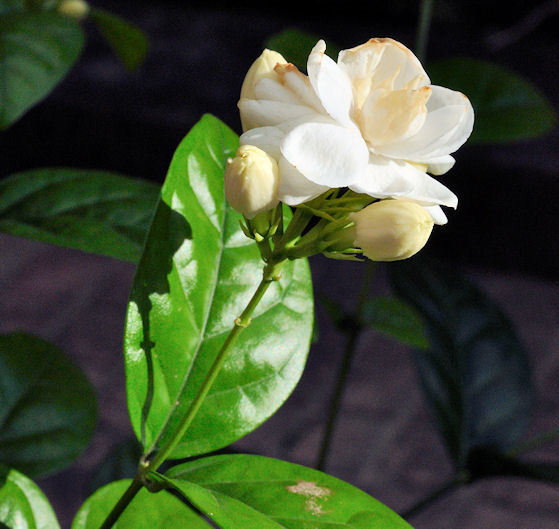
Abb.: मल्लिका । Jasminum sambac (L.) Aiton 1789 - Arabischer Jasmin -
Arabian Jasmine, Kolkata -
কলকাতা,
West Bengal
[Bildquelle: Biswarup Ganguly / Wikimedia. -- GNU FDLicense]
2
धार्तराष्ट्र
-
dhārtarāṣṭra m.: "auf Dhṛtarāṣṭra
bezogen, Nachkomme des Dhṛtarāṣṭra"
|
"DHṚTA-RĀSHṬRA. 1. The eldest son of
Vichitra-vīrya or Vyāsa, and brother of Pāṇḍu. His mother
was Ambikā. He married Gāndhārī, and by her had a hundred
sons, the eldest of whom was Dur-yodhana. Dhṛta-rāshṭra was
blind, and Pāṇḍu was affected with a disease supposed, from his name, "the pale," to be a leprous affection. The two brothers
in turn renounced the throne, and the great war recorded in the
Mahā-bhārata was fought between their sons, one party being
called Kauravas, from an ancestor, Kuru, and the other
Pāṇḍavas, from their father Pāṇḍu. Dhṛta-rāshṭra and his wife were
burned in a forest fire. (See Mahā-bhārata.)
2. An
enormous serpent of many heads and immense strength."
[Quelle: Dowson, John
<1820-1881>: A classical dictionary of Hindu mythology and
religion, geography, history, and literature. -- London, Trübner,
1879. -- s.v. ] |
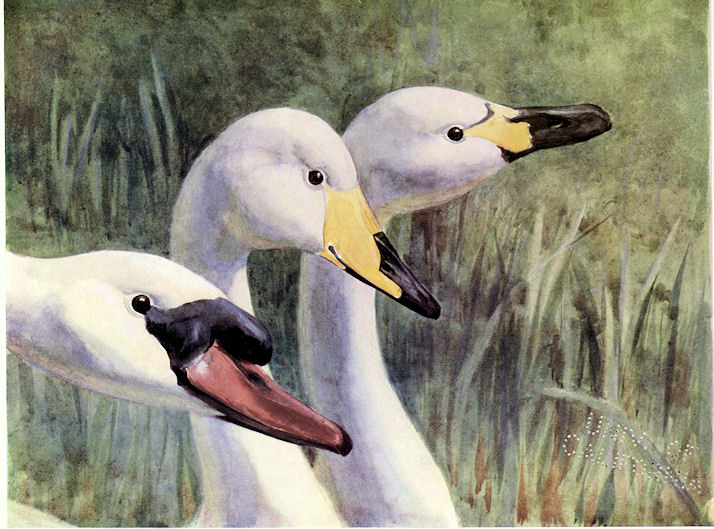
Abb.: von links nach rechts: Cygnus olor Gmelin, 1789
- Mute Swan - Höckerschwan, Cygnus cygnus
Linnaeus, 1758 - Whooper Swan - Singschwan, Cygnus columbianus
Ord., 1815 - Bewick's Swan - Zwergschwan
[Bildquelle: The British bird book, 1910. -- Pl. 155]
Cygnus cygnus Linnaeus, 1758 - Whooper Swan -
Singschwan
152 cm


























































